Sujata Massey's Blog
October 8, 2025
Dan Fesperman on Writing “Pariah”
This post originally appeared on Murder Is Everywhere.
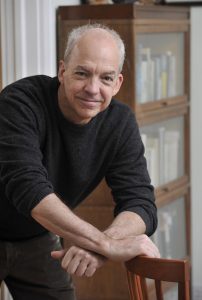
In my youth at the long-gone Baltimore Evening Sun newspaper, Dan Fesperman was a successful hard news reporter who was also extremely kind to the new kids: i.e., the interns and new hires straight out of college like myself who needed tips about where to go to actually get the facts for an article due in three hours’ time. Dan rose in stature to become a foreign correspondent for the company’s morning paper, the larger-circulation Baltimore Sun. Dan covered three wars and spent many years in Eastern Europe, the Middle East and South Asia. Incredibly, his first three thrillers were written while he was still reporting for the paper. Luckily for us, he retired and has sent eleven more books into the world. Dan’s fiction has won two Dagger Awards from the UK Crime Writers Association, the Barry Award for Best Thriller, and the Dashiell Hammett Prize from the International Association of Crime Writers. PARIAH, his latest effort, is set in a fictional Eastern European country called Bolrovia and stars a disgraced comedian (the pariah) turned bumbling (and also brilliant) spy. I asked Dan a few questions about his career and this hilarious and exciting novel. It’s also notable that Dan narrates the audiobook version of PARIAH, and it’s a tour de force with many different accents—as good as listening to the late John Le Carré read his own work. Thank you, Dan, for being a guest author at Murder is Everywhere! —Sujata Massey
Tell us about the spark that became the plot of your newest book, Pariah.
Pariah came to life partly out of my fascination with the strange love affair that developed a while back between American conservatives and Viktor Orban, the strongman president of Hungary, whose power grab over the past few decades presaged a lot of what is happening now in Washington. And, by that, I mean not only Orban’s ultra-nationalism, but also his ability to clear away most of Hungary’s checks and balances on presidential power. He clamped down on the news media, universities, immigrants, dissenters, and so on. American conservatives saw that, loved it, and have set out with some success to replicate it, which is why we’re now seeing similar tactics from Trump and Stephen Miller. And when you start to contemplate how tricky things might be for the CIA to build a network of spies in a place with those kinds of connections, and that kind of affinity to certain elements here, well, a lot of interesting scenarios quickly come to mind. So I was off and running.
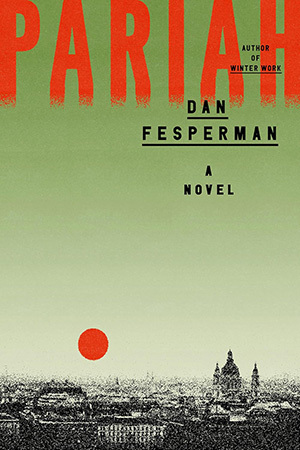
You covered the war in Bosnia in 1992-95. You wrote about the time during and right after the wars in Sarajevo and Croatia in the beginning of your career as a novelist—the two Vlado Petric books. Yet, this novel is set in 2023, and the country, Bolrovia, feels like it could be one of several Eastern European countries that are very popular to visit now.
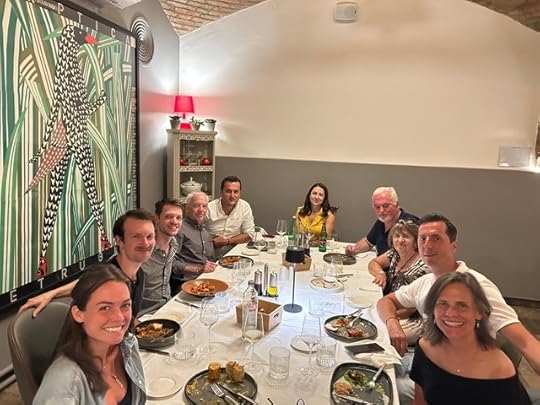 Dan’s recent meal with old friends in Croatia
Dan’s recent meal with old friends in CroatiaI decided pretty early that I wanted to set the book in a fictional country instead of Hungary, partly for legal reasons, but more so because it freed me up to make the place a better fit for my characters and the plot. At first, I thought that would difficult, even a slog, but I quickly began to enjoy building my own world on the rough template of many of the places I’d visited and worked in. My hope was that Bolrovia, and particularly its capital city, Blatsk, would feel instantly familiar to anyone who has been to Prague, Budapest, Zagreb or Krakow. The city’s more compact scale probably most closely evokes Krakow, while its drearier outlying areas bring to mind Zagreb, Budapest and even East Berlin. The Bolrovian countryside feels to me like some hybrid of Poland, Hungary and East Germany. And, as with most of those locations, Bolrovia’s 20th Century history casts a long and deep shadow—a brutal era of Nazi occupation followed in close order by four decades of Soviet domination, which ended abruptly and peacefully in 1989. This is a place in which both the leaders and their subjects know what a crackdown looks and feels like, and the many forms that can take. But I think the most pleasant byproduct of using a fictional setting was that I instantly felt more open to the idea of satire, and that mood soon began to infiltrate my prose. When you then choose a washed-up comedian as your main point-of-view character, the effect is accentuated, because this is someone who will see the inherent absurdity of almost any situation, no matter how dire.
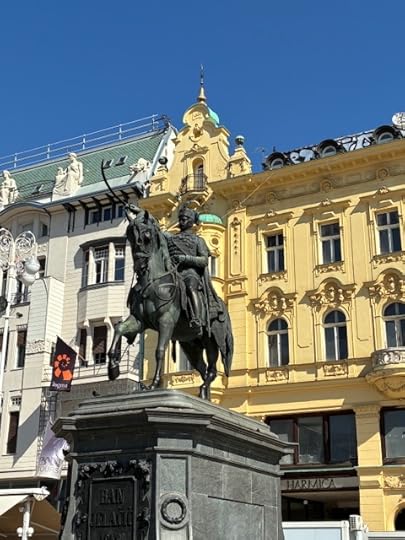 Historic Zagreb
Historic ZagrebTalk to us about Hal and whether there are real-life influences of his character.
Anytime your main character is a comedian-turned-Congressman brought down by a Me-Too moment, Al Franken, the SNL writer-comedian who became a Senator, immediately comes to mind. But I definitely wouldn’t say he was a model for Hal. Hal is quite different, both comedically and in terms of his more disgraceful moment of infamy. He is a bright fellow who knows he has succeeded partly by cheapening his humor with more lowbrow material, nor did he ever take himself seriously as a politician, and in some ways he believes he has gotten what he deserves. As the book opens, he’s laying low on a Caribbean island, aimlessly in search of anything that might offer a new sense of purpose. So, when three CIA operatives approach him to say, “Hey, there’s this quasi-dictator in Bolrovia who loves your stuff and has invited you for a visit, and we’d like you to accept the invitation in order to spy for us,” well, he just might be desperate enough to take them up on it.
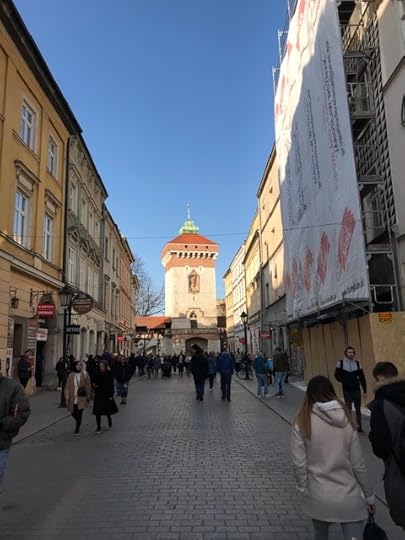 Krakow Street Scene
Krakow Street SceneThe leader of this CIA contingent, and Hal’s handler in Bolrovia, is Lauren Witt, someone with her own reservations about this op. Is she like any CIA agent you’ve met?
That’s impossible to know, because CIA officers out in the field can be operating under cover as aid workers, business people, or, if they have diplomatic cover, they might have some sort of title at the U.S. embassy like “political attache,” or whatever. As a foreign correspondent I sometimes had off-the-record briefings with people who I suspected were working for the Agency, especially when they had more questions about what I’d seen out in the field than I had for them. As for women working in those jobs, I’ve obtained most of that kind of information either from ex-employees who’ve been kind enough to speak to me, or by culling insights from declassified archival material.
How do you manage to research details of CIA work? Tom Clancy got entree to look at warships. Do you have fans in the organization who have helped?
You might be surprised by how helpful ex-CIA people can be once they know you’re writing fiction, and that you won’t be quoting them by name. About fifteen years ago, while doing research for a TV project that was never produced, I interviewed at length around two dozen people whose CIA careers dated back to the late 1940s. Some had even worked with the CIA’s predecessor organization, the OSS. I learned a ton, not only about tradecraft abroad but also about interoffice tensions and rivalries, their social lives in Europe and in Georgetown, and the whole ethos of a life in which you can almost never reveal what you’re really doing, not even to the people closest to you. That material helped shape not just this book but several others, and I continue to seek out those kinds of interviews to inform my work. There is also a load of interesting archival material that the CIA has declassified. Additionally, once you begin writing about this stuff, former employees will get in touch with you, unsolicited, to offer their own tales and insights, either by email or by approaching me after book signings. Plenty of this material creeps into my books. The more you learn, the more you keep learning.
Were you inspired by any Graham Greene novels when writing this book? Our Man in Havana comes to mind. Who are some of your other admired writers in the genre?
Yes, I suppose that influence is pretty obvious. In fact one of my early prospective titles was Our Man in Bolrovia. Another was The Comedian, a nod to Greene’s The Comedians, although that was a far darker novel of his. I read most of his fiction back in my mid-to-late 20s, so I’m sure those influences are still at play somewhere deep in my head. As for others? Well, John Le Carré always comes to mind, mostly for the way that he always put character ahead of action. Among my contemporaries, there are so many to choose from, so I’ll mention a handful even as I cringe because I’ll wish later I’d named more: Charlie Cumming, David McCloskey, Ilana (I.S.) Berry, Paul Vidich, Mick Herron, and… okay, I’d better stop before I run on for another paragraph.
I really think there should be more comic novels in general, and I absolutely love your comic spy novel. Do you think you would do this again (and forgive me if you wrote an earlier funny one that I don’t know about)?
With regard to doing something like this again, my rule is always “Never say never.” As for earlier novels, I didn’t think I had written a humorous one, but in the quite generous and perceptive review of Pariah that ran in the Sunday New York Times Book Review, writer Christopher Bollen mentioned in passing the humor of a previous book of mine, Layover in Dubai, so I went back and read the opening chapter and, yes, it did have a similar tone, at least in those opening pages. It also featured a character who, like Hal, was quickly in over his head, although in this case it was a hapless and naive businessman who got caught up in the darker doings of a colleague. Having said that, the book I’m working on now is in a more serious vein. It’s an update of my main character from Winter Work, an East German spymaster named Emil Grimm, who we’ll rejoin about five years after the events of that book.
Your settings in past have included Sarajevo, New York City, Afghanistan, Germany, Dubai. What does your passport look like? Are you often traveling to fact check this material, or are some places better written about from memory?
My expired passports are probably the most interesting ones, since they include all those visa stamps from wartime travels, or from my first visits to the Middle East. But I have continued to travel on my own dime to many of these places because, even if I’ve already been somewhere, I always feel as if a refresher course is necessary if I’m going to set my next novel there. I returned to Berlin in April 2024 for the book I’m working on now, and I’m sure I’ll continue to do this going forward. As you know yourself, from your own writing and travels, it’s one of the best fringe benefits of being an author.
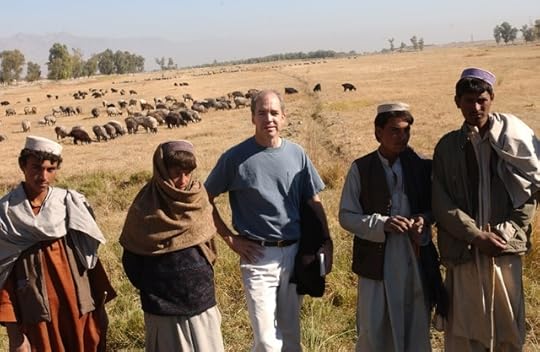 With shepherds in Afghanistan
With shepherds in AfghanistanThe post Dan Fesperman on Writing “Pariah” appeared first on Sujata Massey.
September 24, 2025
All the Countries, or Why Diversity Works
This post originally appeared on Murder Is Everywhere.
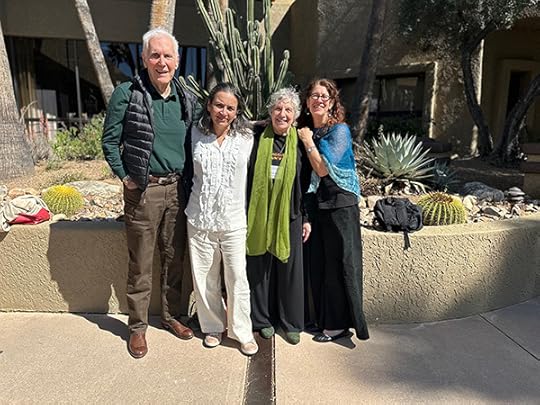 With Jeff Siger, Annamaria Alfieri and Wendall Thomas, Arizona 2023
With Jeff Siger, Annamaria Alfieri and Wendall Thomas, Arizona 2023If you are reading this column, you could have found it at a number of spots.
You might be on my author website or my Goodreads or Amazon pages. However, the OG location for this column is the Murder is Everywhere blog, which is a collaborative writing project of currently ten mystery authors, with at least half a dozen former contributors, including the late author Leighton Gage, its founder. Since the blogsite’s origination in 2008, I’d been an admirer. I was admitted into the ranks in 2012 when I started my Perveen Mistry series and began filing dispatches about my research adventures in India and my more prosaic life in Baltimore, Maryland. To date, this blogging group has included writers with personal backgrounds, or story settings, on all continents except Antarctica. We’ve shared commentary in countries including France, Greece, England, Ghana, South Africa, Singapore, Botswana, Finland, New Zealand, Scotland, Japan, Italy, Spain, and more.
What we do at Murder is Everywhere has been on my mind because of the recent American uproar against the idea of diversity. “DEI” is the acronym that brings together three goals: diversity, equity and inclusion. DEI probably started as workplace jargon, but based on 2023 and 2025 Supreme Court Decisions, and Trump polices, it’s become a red flag. Citing DEI has become a reason to outlaw various programs or fire people from positions of authority.
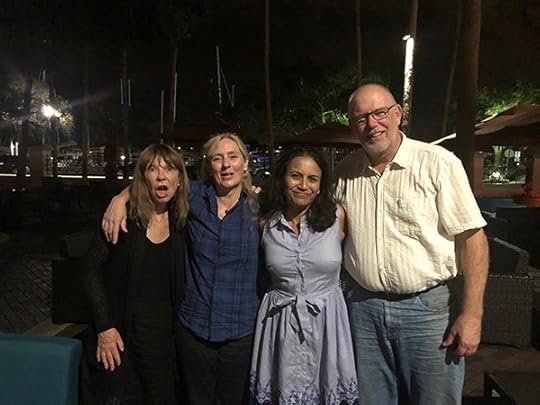 With Cara Black, Caro Ramsey, and Stan Trollip in Florida, 2018
With Cara Black, Caro Ramsey, and Stan Trollip in Florida, 2018I’m sure there are people who might believe I’m DEI all the way: an immigrant who got a green card as a young child, part of a family group anchored by with a scientist father. But as the government saw it, this foreign professor father could do his research at an American university and further the nation’s well-being. Ah, the old ideas about diversity’s benefits! Today, I’ve heard more than 2600 people have lost jobs because of supposed connections to DEI: and hundreds of thousands more—many of them African American—because of the elimination of so many federal jobs.
I lost my Northumbrian accent growing up in America, and when it was time to start college, I had scholarship offers based on high test scores and a stack of essays and extracurricular activities. I yearned to leave the Midwest and wound up in Baltimore, Maryland, where I still live. I started as a freshman at a women’s liberal arts school, Goucher College, transferring to the exciting, co-educational Johns Hopkins University my junior year. In the mid-1980s, the undergraduate population at Hopkins was only 35 percent female and (I’m guessing) fewer than ten percent students of color (a term not yet invented). I remember a question of both admissions forms about whether I had a parent who’d graduated from the institution. Kids who could claim legacy status had a few extra points in their favor.
We all believed that there were tricks to the admission process.
My husband Tony and I met at Hopkins, and we still joke about being the scholarship kids who got in because of our underrepresented home states—Louisiana and Minnesota. College admission materials often included statistics about state and international backgrounds of students. It’s a policy that probably results in more people back in the faraway states learning about the school from the student’s family, and it also made the campus more vibrant. I treasured listening to music introduced by a friend from Brazil, and hearing the accents of my buddies from small-town Tennessee and Manhattan and New Jersey. We heard about life in Johannesburg from a South African student who was wary about returning. One downside was a lack of African American students from public school backgrounds. It wasn’t until after 2012 that Hopkins started a robust scholarship program for all qualifying students from Baltimore City Public Schools that still continues.
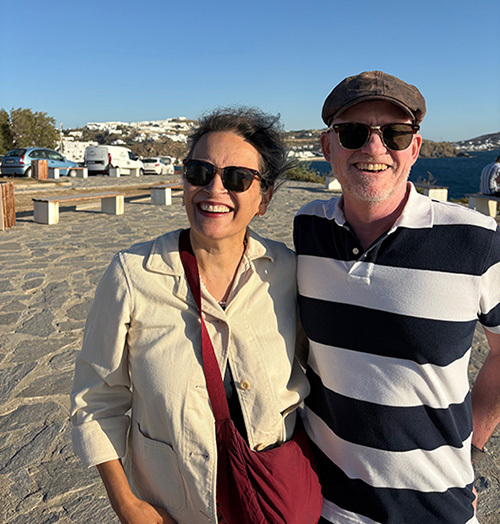 With my husband Tony in Greece, 2025
With my husband Tony in Greece, 2025I graduated to work at a daily newspaper in Baltimore. Journalism jobs are notoriously hard to get, and in those days, most editors were white men. I was hired at the Baltimore Evening Sun, the now-defunct sibling afternoon paper that competed with the morning paper named the Baltimore Sun. Probably the competition was just a good-natured one between the reporters, since the money all went into the same pot. During my time, the Evening Sun had a particularly strong bench of Maryland-raised, Black reporters. Many of these friends had undergone the paper’s four-year, paid summer internship program offered to University of Maryland journalism students who hailed from the newspapers’ circulation area. The program was clearly in the newspaper’s interest, because it meant developing strong young reporters who already knew their way around and had social connections giving them access to sources that an out-of-state reporter might take years to cultivate.
My route to the Evening Sun also came through an informal internship meant for Baltimore college students during the school year. I loved the work doing general assignment stories for the city desk and felt warmly welcomed by the energetic young reporters. When the internship year ended, I jumped at the the chance to come in and help on Sundays with a reporting job done mostly by phone: contacting the police and fire department to tabulate the weekend’s tragedies; and news broke, speeding to the scene to report on it. Ironically, I interviewed for a full-time job at the Raleigh News & Observer where I mentioned my police reporting background. The editor told me: “We don’t have women reporting on police stories because the cops don’t like talking to them.” Even though it wasn’t my life ambition to be a police reporter, I took the editor’s statement as a sign not to take the job they offered. Instead I took a job at the Evening Sun, the happiest workplace of my life.
I am sharing these personal experiences as my own brush with what can happen when under-represented people are welcomed in. Bringing the idea to a higher level, we see that Google and Apple and Amazon exploded into success due to using smart and capable IT workers from around the world, along with American citizens. It’s not right that H1b visa workers are often paid less than an American worker for the same job; but we also have to acknowledge that these salaries are more than in the home country, and fewer Americans pursue math and computer science than do students in China, India, Russia and Germany. This means: fewer qualified people.
Currently, America has a growing challenge of unemployment. The Pew Research Center finds that in the 25- to 34-year-old bracket, 47% of college degree holders are women, while 37% are men.
The reasons for this seem to be varied. For example, we’d carefully saved for our son’s college education, but he wasn’t particularly interested in going and also had the bad fortune of starting freshman year in 2020, the pandemic year. He lasted three semesters and only decided to return to studies this year. But this time around, his motivation is strong, and his brain is a few years further down the road in terms of development.
Slightly more females than males work at part-time jobs during high school, and they are often tasked with care of family members as well. Does having ability to manage multiple roles lead to better focus in college? A lot of studies on video game interest show that boys are more attached to this pastime than girls. And everybody I know seems to have a relative or friend whose son who doesn’t work at a job, but matures into adulthood stuck in the basement gaming. Why would anyone want to live like this? Does long-term gaming alter the brain’s pleasure centers that make it harder to feel satisfied by studying, or undertaking complex intellectual tasks?
In the past, teenagers had very different paths. Parents expected their sons to apprentice, enter trade school or university during a time that some daughters unfortunately had circumscribed choices for higher learning. It may sound radical, but I’ll argue that some boys and young men could benefit from diversity programs. They too can be supported as students, workers and human beings, and in this sphere get genuine connection with people who don’t look like them.
As I said at the start of this essay, there are different places to arrive at the essays published by Murder is Everywhere. Platform diversity helps writers connect with readers, just as a diversity of workers supports the world.
The post All the Countries, or Why Diversity Works appeared first on Sujata Massey.
August 27, 2025
Mise en Place: How I Organize My Writing
This post originally appeared on Murder Is Everywhere.
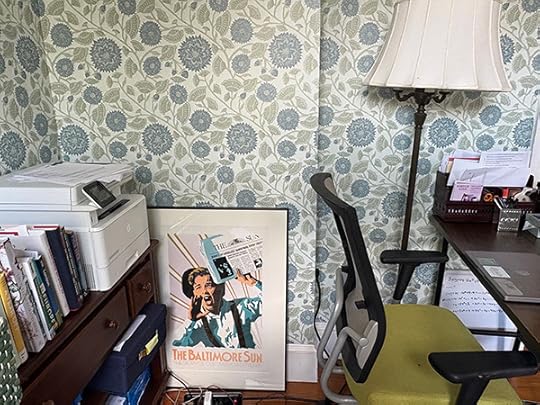
This year I moved my desk and laptop into the long skinny room running along the back of our third floor. And this has changed not only our house—but also my writing life.
It’s always been a difficult room. An oddball zone with great windows, but nowhere to place a bed. Back in the 1890s, the room was an afterthought without serious interior function. Doors dominate three of its four walls. Two large windows allow for copious sun all day long, and an adjacent laundry room has its own wrap around windows adding more sun to the party. Our plan for this sunny but awkward room was for it to be the television place. That idea fell apart because we affixed the TV up high on a short wall—a truly terrible location. The couch fit on a wall adjacent to it, not facing, so any attempt to watch resulted in a cricked neck. So we didn’t watch TV there or do much of anything except store and wrap Christmas presents, because nobody would think to go there and snoop.
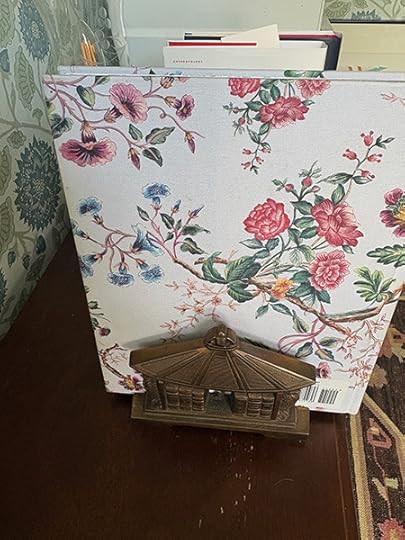
I decluttered the room, which also became a catchall for storage, after ten years. I then consulted with Wesley Finnerty, a smart local decorator who knows these quirky old houses. We brainstormed ideas on how how we could turn this room into a writing place because there certainly was room for a desk (although not many bookshelves). I chose a blue and white floral wallpaper print based on Indian woodblocks appropriately called Jaipur. It’s bold and surrounds me in a way that supports focus. I brought up some furniture from downstairs: an old mahogany cabinet with three shelves that could hold supplies, as well as a console that could hold the printer and papers. At auction, I nabbed a mid-19th century settee that was narrow enough for the room. Someone before me had re-upholstered it in a funky blue velour, and it just fit. I also had an ottoman upholstered 25 years ago with a William Morris fabric that has traveled with me everywhere. Why not here? It means I can sit on the settee, put up my feet, prop a cushion on my lap and get to it on the laptop.
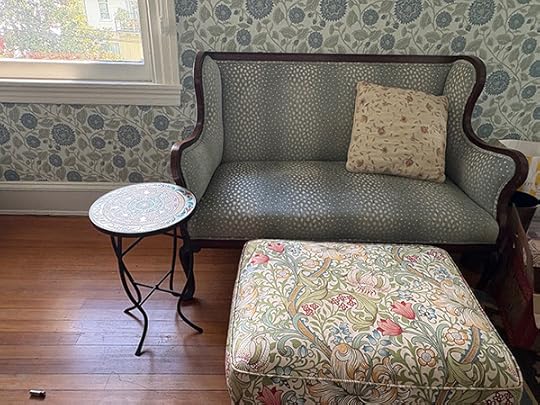
Yes, I have a modern office desk and a very comfortable chair. I am there less than half the time.
Moving into this room, though, and having just one cabinet and one console table, has forced me to be a little more organized. My typical style is to keep research materials for each book in a large cardboard box, and to stack pages on desks and any other surface I can find. Now, I’ve moved more into using folders…and keeping folders in cases. And I’m also recycling papers faster than I used to.
I truly wish I could adjust to digital storage. But my mind doesn’t remember things as well when I read them online. This is why I print out my pages as I go along to be able to see my repetitions of ideas and other errors. When writing a 110,000-word novel—as my books tend to average—I keep track of more than a dozen important characters, all of whom have their own physical and linguistic traits, their own schedules, and roles in the story. As a historical mystery writer, there’s the added necessity of research (aka the fun part). Every writer has their own methods, but this is what I’ve fallen into over my 30 year-career:
Boxes. They are not spread out willy-nilly like before, but I am keeping just one modest-sized box in this room. It’s the place where I protect any information I’ll need to refer to while writing. I typically gather facts from old books and records housed at the Ames Library of South Asia at the University of Minnesota. It’s 1100 miles away, and I get there just once or twice a year. The fastest way I can save pages from rare books for detailed reading later is by snapping photos on my phone that I read later. Some of these I’ve printed out to serve as a weird kind of photocopy. I also snap a shot of the book and author and publisher details in case I want to mention it in the acknowledgments or even try to buy a used copy from somewhere in the world, if it still exists.
Folders. I keep folders within the boxes of subcategories of information. For example, I have a folder about Dadar Parsi Colony, where my character Perveen lives, with a rough map and articles about the history of the place. I also take photographs of this Parsi colony each time I visit Bombay, just as I take photos of preserved architecture in other historic areas, like Fort and Malabar Hill. Other much-used folders relate to British colonial government and police organizations, women in law, and sari fabrics. And food, naturally!
Character Sheets. I came across this concept when searching online, and there are a lot of PDFs of character sheets to play with. These worksheets ask the writer to record details about each character and are guides for keeping facts straight in the current book, and future books if you happen to be writing a series. I have made them for Perveen’s family members and her closest friends. The trickiest parts are remembering the date of a character’s birth, so the people have ages that are correct in relation to the series’ progression. For instance, Perveen was born in 1898, so for the book I’m writing now, set in 1923, she’s 25. The only character I wish I could age faster is the book’s resident infant: Khushy Mistry. I am frankly tired of a character who can’t walk or speak. In the current book, Khushy has made it to 14 months—hurray!

Index cards and Timelines. I write mysteries, and once I’ve got to the point in the story where someone dies, timelines and who-was-where-when becomes very important. As I get into a second draft, I usually find I need to rearrange some scenes and also remember what happened at various stages: when people could know the facts that I say they know. I summarize each chapter on an index card and tape it along with a bunch more (my books are typically 32 chapters) to a 17-inch manilla envelope. That envelope serves as a flexible kind of bulletin board that I can lay down on the carpet and study. I probably should put up a bulletin board on my fantastic wallpaper, but I’m a little fearful of getting the spot wrong. Besides, envelopes are good because the surface for the cards needs to be a long vertical space, rather than horizontal.
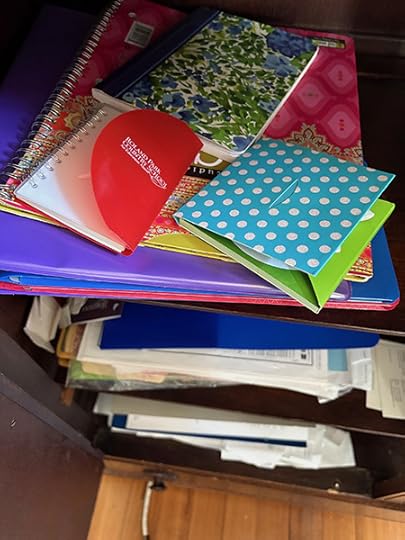
Notebooks. Oh, how I love them. And I never turn down freebies. While on the road, you can carry a small notebook in your bag or pocket and take it out to jot down notes that people tell you—or details that you observe. The key is to mind your handwriting, going slow and carefully enough that you can read your own writing later. This is a genuine problem for me.
A library of books. Most of the novels and nonfiction I keep about India can’t fit in the new study. However, I bought an antique brass expanding book rack on eBay that can be set on any desk or surface. It can be pulled wide enough to hold 20 books upright, or be collapsed to hold as few as five. I can imagine students of the early 20th century traveling to a dormitory or boarding house and setting up their row of necessary textbooks in such modest racks.
Reviews. Not all writers want to read their reviews, especially on the internet. However, in the golden days when my career started, newspapers and magazines printed lots of book reviews, and wrote feature articles about authors, too. Even though I don’t read these things, it’s lovely to have a clipping about The Sleeping Dictionary from the Baltimore Sun of 2013, or a color photocopy of clipping about The Salaryman’s Wife from People Magazine “Page Turner of the Week” from 1997. I also store marketing materials (like how to strategize Instagram, etc.) in the same area.
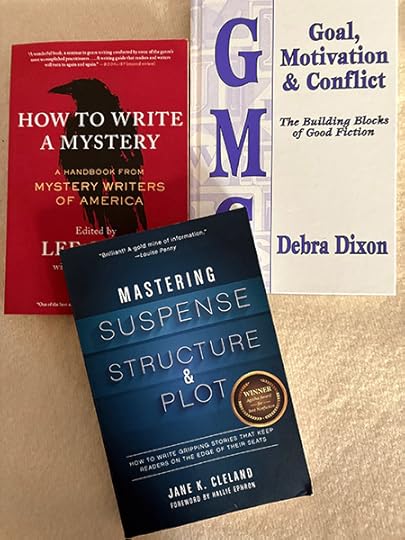
How-Tos. I keep a section of craft books not for sewing, but for get-back-to-writing inspiration. I keep them together in the library, though I might allow one down in the study for times I get antsy. I am trying to get my hands on a paper copy of Virginia Woolf’s long essay, A Room of One’s Own, which bursts with indignation, activism, and amazing details of early 20th century English literary life.
There you have it: the scaffolding that surrounds me as I embark on a new book. Protective walls, powerful sun streaming through the windows, and all the necessary aids. But it’s not until little Daisy the terrier jumps up on the ottoman, that this writer’s mise en place is complete.

The post Mise en Place: How I Organize My Writing appeared first on Sujata Massey.
August 14, 2025
Summer of My Discontent
This post originally appeared on Murder Is Everywhere.
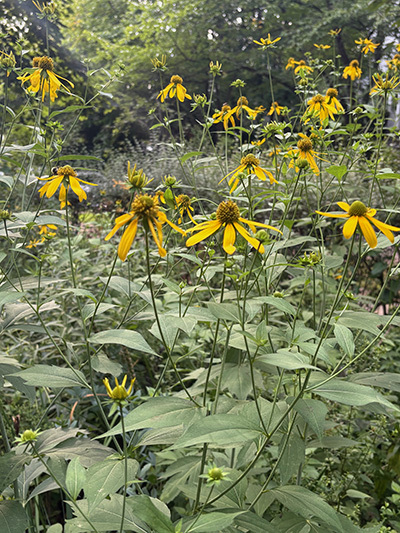
I have a sentimental relationship with summer. To me it’s a season where certain traditions find their way into three months. I have grand expectations for June to August. I’ll know that I’ll eat a few dozen ears of corn on the cob. I anticipate getting at least my toes into the ocean or bay or a lake, with good company beside me. I look forward to a few roadtrips with a packed cooler of good food. Riding in my car, I expect to keep hearing a pop song that’s mysteriously caught on with so many deejays that it’s become the de facto summer anthem. During my singleton days, there would also often be a summer romance that would begin in May or June and end before Halloween. Summer always brought tastes of peach cake, berry pies, and homemade ice cream.
I’m older now, and if you asked me two days ago about how things are lining up with expectation, I’d say the only consistency is that the corn has been good. In the midst of a heatwave, my husband and I left 90-plus Baltimore on a strenuous drive to move our son to Nashville, where the weather was even worse. This summer, we got no closer to a body of water than driving by the Baltimore Inner Harbor.
Oh, this summer does seem to be the one which rebels against pattern. Covid walloped me coming home from a late spring trip to Greece. The good news was I only felt ill for one day—and as far as I know, none of my contacts caught it. But a month after Covid, two insect bites appeared on one arm, both ringed with round scarlet rashes. I didn’t think tick bites ever came in twos and was ready to believe it was spider bites, but muscle and joint aches and brain fog followed. I went on Doxycline for two weeks. Yesteryear’s summer romance had morphed into a dangerous one-night stand with someone who wanted to leave me with Lyme Disease, Ehrlichiosis, Babesiosis or Rocky Mountain Spotted Fever. All over the US in 2025, tick-borne illness is exploding, and I remain very grateful to have been prescribed medicine which actually fought the infection. I recovered, re-emerging from health anxiety into a city where the heat had stayed brutal from its late June on set into early August.
When I read a weather forecast and know the day will be miserable, I rise at 5 a.m. to experience a few pleasant hours. One of my great pleasures during these times is reading the Sunday New York Times with morning coffee on my front porch, which has a gently whirring ceiling fan. I tried to keep the tradition going, but reading the papers these days makes me anxious. Famine and death and invasion of Gaza, and more than 60,000 people in America dragged off to detention, mostly without due process. And then I see articles about discontinuing vaccines, shutting down science research, firing government service workers, and shackling universities to censorious oversight. The Voting Rights Act is at risk, and the National Guard have already been sent by the president to break up protests in Los Angeles and remove the homeless from Washington DC.
I don’t know if there is a pop song that’s evocative of this summer; it would probably be too profane for me. I’ve been busy listening to podcasts, though. Favorite are The Ezra Klein Show, We Can Do Hard Things, Rick Steves Travel, and, to fall asleep, Nothing Much Happens. One day, I heard a cookbook author being interviewed on the PBS radio cooking show, Splendid Table. The author, Nicole Rucker, was describing elements of her unorthodox pastry and cake recipes to show host Francis Lam, and I started to salivate. I realized that I hadn’t had a single piece of pie yet. Poor me!
A few days later, I got blueberries and blackberries at the Saturday farmers’ market, and I also bought the cookbook. Fat+Flour. I got going on a Monday, right around the time I should have been making a sensible, sugar-free dinner. But I had a couple of sticks of Kerrygold butter and was going for broke.

Straight off, I’ll say that the book’s subhead promises “a simple bake,” and the recipe I followed for Blueberry-Lavender Pie involved many hours of work—starting with making a crust dough that needs chilling to set up before it’s rolled. My freezer was opened and shut for various processes, including freezing half the fruit for the pie, chilling the liquid that goes into the crust, which and then chilling the pie pan with a crimped crust, and later the fully assembled pie with its tasty cream-cheese-butter-flour crumb topping. With oven time of one-hour, the entire process took me almost 5 hours. I found that I really didn’t mind cooking for so long, just for myself, in a quiet, air-conditioned kitchen. The process of following steps was so complicated that allowed me to focus. I’ve heard of moving meditation. Is there such a thing as a cooking meditation?
I waited almost the recommended hour to cut into the warm pie. The butter-flour-sugar-salt-cider vinegar crust had strength and tenderness and a great flavor. The berry filling—different from the recipe because I added blackberries, and a lavender-lemon syrup instead of culinary lavender—was tartly glorious. This pie reminded me of the mythical marvels I’ve tasted at roadside diners and pie shops in small-town Wisconsin and Northern Minnesota. But no Crisco in this pie—just Irish butter, three different kinds of sugar and berries from Black Rock Orchard, a steadfast fruit farm I’ve known for decades.

I wasn’t planning on blogging when I was baking and eating last night. I wish I had a picture to show you of the whole pie . . but this is what I’ve got left. I’ll eat a bit more every day. And I will bake another pie, using this book, no matter how complicated it might be. Pie-making brought summer back to me, it’s just that simple.
The post Summer of My Discontent appeared first on Sujata Massey.
July 30, 2025
To Be . . . or not to Airbnb?
This post originally appeared on Murder Is Everywhere.
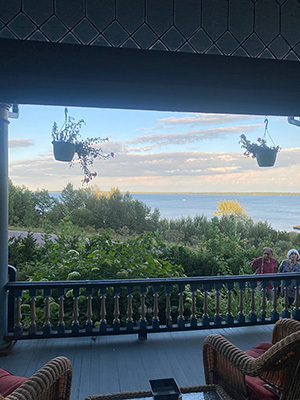
I recently finished writing an honest 5-star review for the charming cottage in East Nashville. As you probably guessed, I booked it through the business website, Airbnb. Isn’t that the first place one consults when looking for an overnight stay far from home? And while I was grateful for a smooth, uneventful stay in an air-conditioned house in what seemed like the hottest city in America, I didn’t feel 100 percent about it.
I am trying to kick the Airbnb habit. But it’s hard. Looking at the photo above, shot from the porch of a Victorian home Airbnb in Bayfield, Wisconsin, you can see how much good luck I’ve had with Airbnb.
Still, I’ve heard a lot of negative chatter about Airbnb this summer. In June and July 2025, local people came together to mount mass demonstrations throughout Europe protesting the rampant and unregulated short-term rental culture in their cities and towns. It happens like this. Tourists and digital nomads blow into town during good weather—which in Southern Europe, can run most of the year. They book themselves into apartments for anywhere from a few days to six months. These mostly-millennial and Gen Z folk can pay rents that are sometimes quadruple the regular rate for long-term local renting.
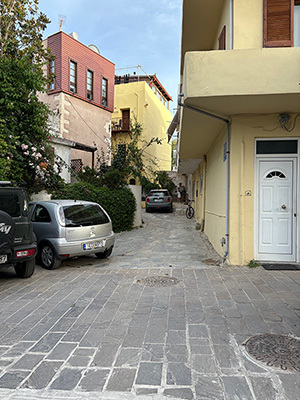 We stayed in the tall house just beyond the car
We stayed in the tall house just beyond the carThis desperate situation has arisen because landlords are commonly evicting long-term tenants to turn ordinary flats into souped-up temporary rentals. Local people on salaries that might have allowed for 500 euros rent per month maximum are out in the cold. Now they may have to move from their hometowns to cheaper places, live in cars, or stay with their parents forever. In Crete and on other Greek islands favored by tourists, locals often can only find apartment rentals for 8 or 9 months of the year—the non-tourist months. I’ve seen news reports where Greek and Spanish working people have become homeless and live in their cars. A similar housing crisis is playing out in Dublin, Ireland, not only for reasons of tourism and nomadic workers, but because of mass permanent migration of wealthy foreigners taking advantage of low taxes.
Especially in Barcelona, the summer protests have involved firing flares and water guns at hotels, tourist vehicles and even some cafes where tourists are sitting. There have been less in-your-face protests in the Netherlands, Greece, Italy and Portugal. This is a spread from similar tourist protests in Spain in 2024. Many tourists staying in countries during the protests have expressed an uncaring attitude, usually reciting the old cliche that foreign dollars make these countries prosper. Some people prosper, to be sure. But not the everyday Joe.
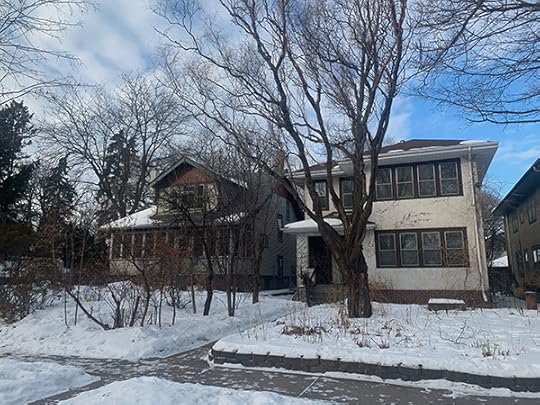 Our historic St. Paul duplex lodging is on the right
Our historic St. Paul duplex lodging is on the rightIn the US, short term rental housing companies include the company VRBO (Vacation Rental By Owner) and others in addition to Airbnb. And this tourism option has impacted lots of cities, including my childhood hometown of St. Paul, Minnesota. In St. Paul, downtown hotels are losing business, because businesspeople travel less frequently, and the parents visiting the area’s college kids have the chance to stay a few blocks away in historic houses like the one pictured above, where I stayed in 2022 during a chilly weekend. In a variation of this concerned college-parent theme, I booked the Nashville cottage in order to have four or five days to help my college-bound son find and lease his first apartment. I liked staying in a quiet place with free parking and no buses full of drunken bridesmaids.
Neel and Tony and I found him an apartment, but it was expensive than I expected. In Nashville, most apartments seemed to be in the $1800 to $3000 price range. Wistfully, Tony and I recalled an era when rental prices didn’t rival house mortgages. In the mid-1990s, we rented a 2 BR, 2 BA apartment in a large 1920s Baltimore building for $1000 a month plus utilities, with just two washers and dryers for everyone to use in the haunted basement. We rose early to find a free machine to wash clothes, but we did manage to save money and buy our first house six years later.
We really liked our apartment, but we absolutely loved our first house, and the two that have since followed. Houses have personalities and quirks that feed into the allure of staying overnight somewhere, in privacy.
There’s a bit of a gamble with each Airbnb. I punch in a code, turn a knob and hope that the place matches the pretty website photos. I feel lucky when the place is lovely, filled with comfy sofas, tasteful art, and more than one bed and bathroom. There also have been times when the place I booked reeks or has uncomfortable bedding, anemic plumbing and no more than a two plates and two glasses in the cabinet. And what about the always-recording Alexa device left plugged in? Warning: if you leave a critical review about any of this on Airbnb, the owner might get their revenge by grading you as a terrible guest.
During our recent two-week-long trip to Greece, Tony and I traveled widely. We stayed in three small hotels, but we started off with four nights in an Airbnb in Chania, Crete. Our abode was a tiny, traditional house just one room wide with a steep, winding staircase that went up three stories. It was a blessing to have a separate floor to tiptoe down to during restless nights with jetlag. More recently, in the East Nashville Airbnb, we enjoyed morning coffee on the back porch overlooking a yard and forested area. A good house, stocked by a caring person for guests, is a haven.
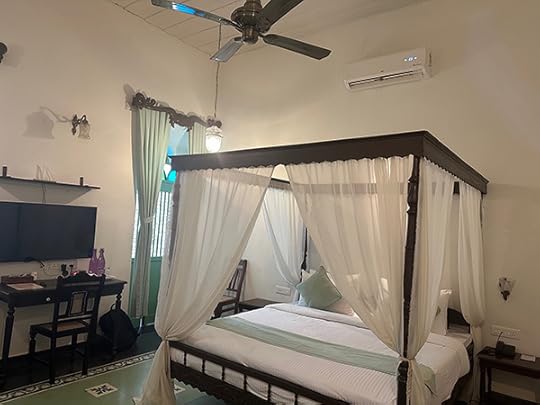 Silva Heritage is called “Home Stay” hotel in Goa, India
Silva Heritage is called “Home Stay” hotel in Goa, India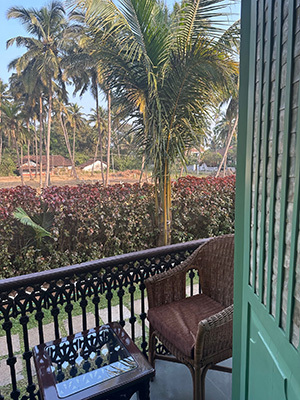 Silva’s 300-year-old farmland seen from the room’s balcony
Silva’s 300-year-old farmland seen from the room’s balconyAirbnb meant “air bed and breakfast” originally. The first Airbnbs I heard about were spare rooms in someone’s apartment. This type of arrangement is similar to being a “Paying Guest” in someone’s bungalow in India, or pensione in Italy, or domatia in Greece. And speaking of domatia, I remember fondly staying in several during travels to the Cyclades back in the late 1980s. In the pre-internet days, the only method the owners could attract you was by coming in person to the port, calling out, and holding up signs with photos of the lodging.
I find the advantage to a true homestay is the cultural connection with its owners who can help you in so many ways. We were saved by the kindness of our Airbnb owner in Chania, who did live next door and communicated in Greek with the local airport to deliver our lost luggage. It seemed to me that the little house we stayed in was probably family property, rather than investment, because she told me that her electrician husband had done all the complex lighting in the house. However, a faraway management company had come to handle the bookings and billings in recent years.
Here I am, pondering whether there is any chance for change—or if this is an inevitable, permanent reshaping of who gets to live where. Can governments fix this for the better? And what would shift things to send more tourists into hotels and thus save lodging for year-round people?
Hilton and Marriott have been offering for years all-suite hotels that are budget- and family-smart, but rather short on charm. Different hotels could reshape their existing infrastructure to include more genuine, two- and three-room suites with homey features—including coffeemakers and microwaves, which seem to vanish the more a room costs. And why can’t a good hotel have some washers and dryers, now that same-day laundry valet isn’t always offered?
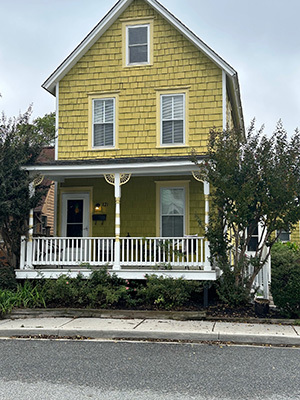 Airbnb Victorian cottage in Lewes, DE
Airbnb Victorian cottage in Lewes, DEInevitably, travelers press on. We can dare to make our journeys with the intent to speak at least a few words of the local language, and to perhaps stay in towns where there aren’t too many of us. I acknowledge there are some countries and towns where Airbnbs aren’t such a drain on the local housing market, and renting one’s house might be important income for someone who doesn’t have paying work. It’s just that when a particular town becomes too famous and too popular, that the problems begin.
Right now, I am in the slow-planning stage of various trips to the United Kingdom, Greece, and Spain. This time, I’m researching smaller hotels and actual bed-and-breakfasts. Do B&Bs still exist? If you know a good one, tell me.
The post To Be . . . or not to Airbnb? appeared first on Sujata Massey.
July 2, 2025
More, More Mykonos!
This post originally appeared on Murder Is Everywhere.
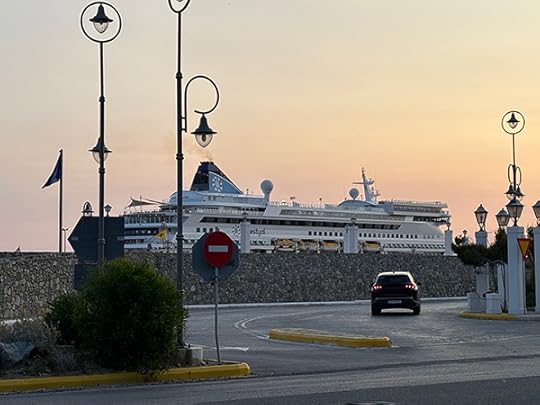
It’s rare luck to be out traveling and run into friends from home. But that is what happened last month: we went to two islands of my choice first, and then to Mykonos because that’s where Jeff and Barbara were.
My friendship with crime fiction author and co-blogger Jeff Siger began at a mystery convention more than ten years ago. I had the added pleasure soon afterward of meeting his wife, the artist Barbara Zilly. I was impressed to learn that Jeff had been a regular seasonal dweller on Mykonos for years, giving him a local’s knowledge to use for his writing. Since Jeff has been an honorary Mykonian for about 40 years, and spends quite a few months there, it’s more like a home stay merged with work. Tony and I are contemplating being overseas much more, so this was a splendid chance to learn from the professionals.
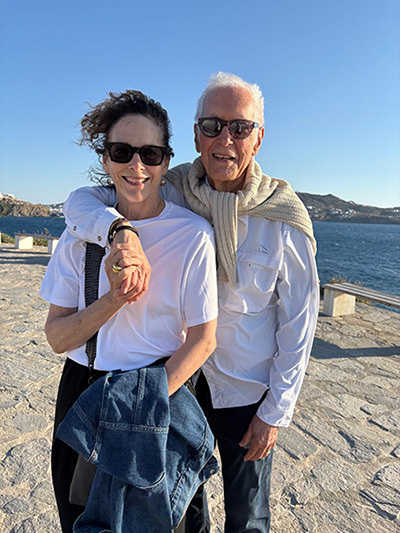
During the short, smooth, ferry ride I pondered our destination. Mykonos is quite small, and its name has something to do with a pile of stones, which certainly reflects the way it looks, or maybe also because it’s named after a a legendary long-ago ruler, Mykonos, a son or grandson of Apollo. I also heard from Jeff that it’s known as Island of the Winds. The triple-possibility explanation of the island’s name reminded me of all the multiple explanations for place names in India. Also like most districts in India, Mykonos is a very crowded place. The nine-mile-long island has 10,700 regular residents, but manages to be Greece’s second-most touristed destination after Santorini.
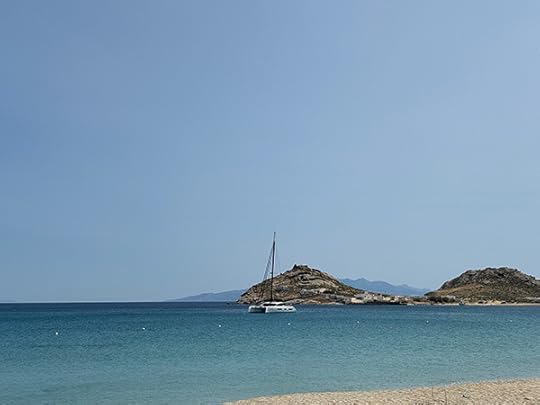
We’d visited Santorini on our 1990 Greece trip and found the hordes of people made it hard to enjoy the spectacular cliff views. These days, we knew Santorini had become even busier, and we expected the same for Mykonos. This was traditionally an island with working class and poor dwellers that shot into the limelight in 1961,when American First Lady Jacqueline Kennedy visited with her sister, Lee Radziwill, and a few others. Jackie’s time on the Pile of Stones was part of a larger tour of Greece, but of all the locales, apparently Mykonos became her favorite. After marrying Aristotle Onassis in 1968, might her heart have gone to his private island, Skorpios? I wonder.
In the 1980s, Mykonos exploded as a jet-set party destination, and as we got off, we saw so many fellow tourists who fit that decadent description, as well as three-generation family groups from all corners of the earth. Essentially, it was like the crowd at any international airport around Thanksgiving.
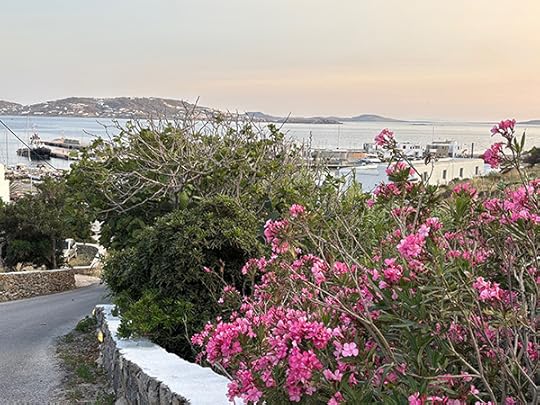
The wait at Mykonos Port to get a taxi was a lot longer than the 3-minute ride up a stony hill to Hotel Rhenia, a business owned by Jeff and Barbara’s hotelier friends. We checked in at a sunny courtyard, where the embraces from Jeff and Barbara were just as warm. The sky was dazzling blue, and we could see multiple cruise ships pulled in. How many of the people crowding the port were from the cruise ships, I wondered? I learned later, the cruisers go back during the day; and nighttime is for the partiers staying on the island.
That night, the winds whipped as we strolled Chora, the old original village that is the town’s epicenter for shopping, food and nightlife. The style memo was young, fancy, sexy, and wild. We were. beyond it all, though. As we ambled past shops and restaurants, Jeff and Barbara were greeted like returning neighbors who had been away too long. The Sigers know EVERYONE. The museum founders, the restaurant chefs, the jewelry store guards and the managers, the opticians, the restaurant chefs, the boutique owners, the artists, the local characters… a two-block walk turned into a receiving line of dozens of incredibly friendly people.
Jeff and Barbara brought us to a favorite spot where we had a luscious dinner at a nouvelle cuisine restaurant. There, we planned for the next day: off-road touring in the couple’s rugged jeep to some beaches, and other destinations that would not be overrun by the crowds we were squeezing through in Chora. It would be nice not to see another Rolex store or chocolate boutique!
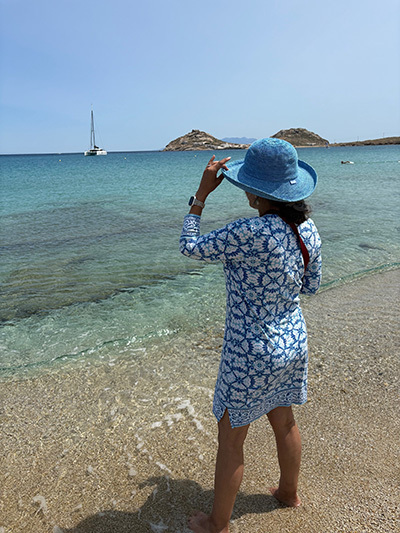
The next day’s trip rambled and rolled from paved roads to dirt and stone paths, many of them narrow and uphill. Jeff drove like Mario Andretti, backing up and executing hairpin turns without the slightest hesitation. We raced along country roads where the tourists were nonexistent but occasional vehicles would need to play nice with Jeff. He was intent to show us the pleasant swimming beaches most tourists don’t know. So SSHH!!
These locations included the small Kalafatis Beach, with only two people on it, and two famous rock islands in the sea nicknamed the Mounds of Aphrodite—you can come to your own conclusion about what that means. I was getting the feeling there are all kinds of names for the features of Mykonos.
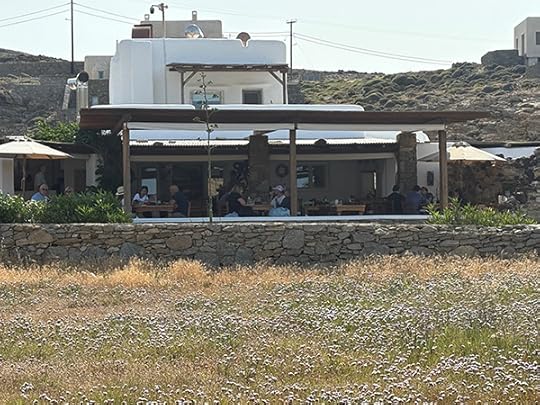
After a great lunch including greens, beans and squid at a taverna on Fokos Beach, another quiet spot, we reached the island’s famous working monastery in the village of Ano Mera. Panagia Tourliani translates as the Virgin Mary of Tourlos, also patron saint of the island.
Built and rebuilt during medieval times through the 19th century, the monastery is simultaneously both a white-washed Cyclades classic—and its interior full of as much gold and treasure-laced decor as Greek Orthodox churches elsewhere. We toured the stunning main church filled with icons and dripping with golden chandeliers. Upstairs, some of the monastery rooms hold treasures of ancient religious clothing, texts and items used in worship. Barbara speaks Greek very well and related that a monk had told her that it was a good we hadn’t come the next day—when four cruise ships’ worth of passengers were scheduled to visit. Once again we had been lucky!
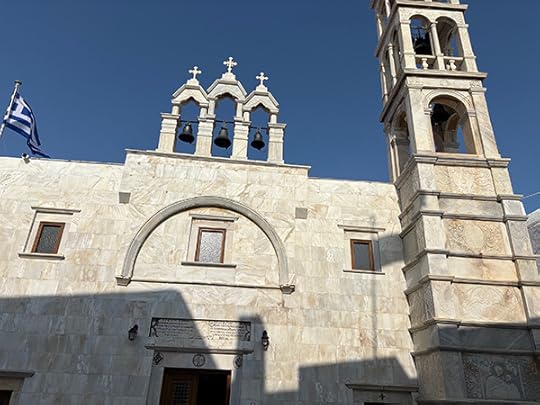
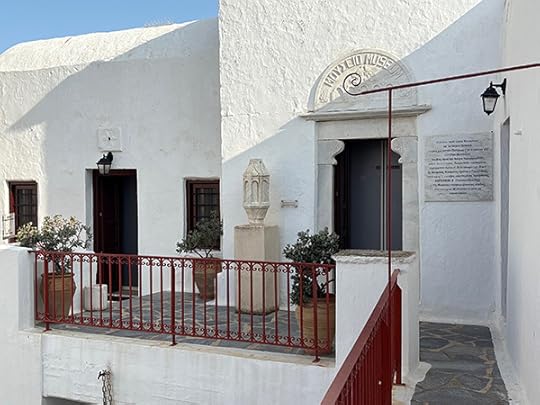
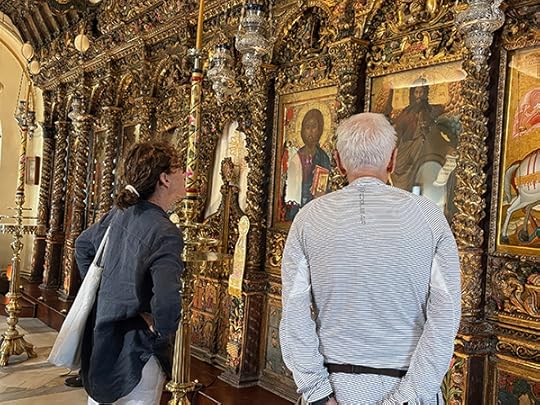
That evening we were still too filled from the delicious lunch to want to eat anything more. I packed up my carry-on and swatted at gnats who’d come in the open windows of our hotel bungalow. Jeff was resting and Tony and Barbara hung out with drinks in the hotel courtyard.
It was the last night for us after two weeks in Greece. While I hated to leave, I also felt renewed. I had seen so much water, so much sun, so many indescribable antiquities. Even in the presence of mass tourism, these gems remain to be found, and I was grateful to Jeff and Barbara for showing us Mykonos’s hidden side.
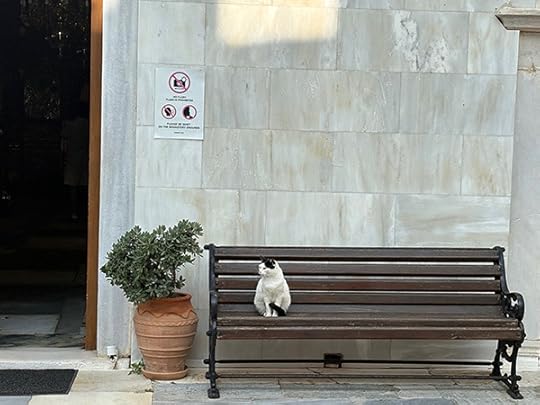
The post More, More Mykonos! appeared first on Sujata Massey.
June 18, 2025
Sweet as Syros
This post originally appeared on Murder Is Everywhere.
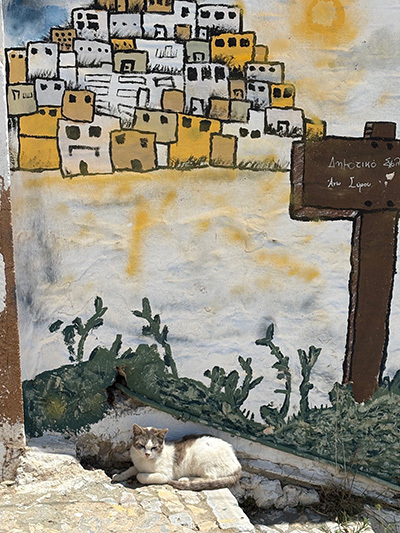
I didn’t think of Greece as being a big country. But when I dug into the geography while planning my recent trip, I found Greece has a significant mainland plus over 6000 islands and islets, with 227 of them habitable.
227 islands!
These potential 227 choices present a dilemma to anyone who is interested in the Mediteranean and visits Greece more than once. The question is: if you’ve discovered an island that captivates you, should you return? Or do go on visiting more places that you’ve heard are special?
Greeks on the mainland also love their islands. I also have heard they tend to align with a particular island, often because of family history, and visit it a few times a year. They build relationships and have a home away from home.
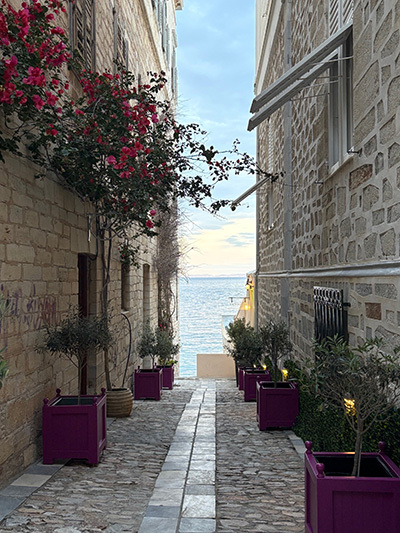 Vaporia District
Vaporia DistrictI suspect most foreign tourists (myself included) tend to relentlessly explore as many as they can. Yet certain islands will always get the largest numbers of people, and they are Santorini, Mykonos, Corfu, Rhodes, and Crete, the place where Tony and I started our trip. But now we were having a new adventure on the way to the island of Syros.
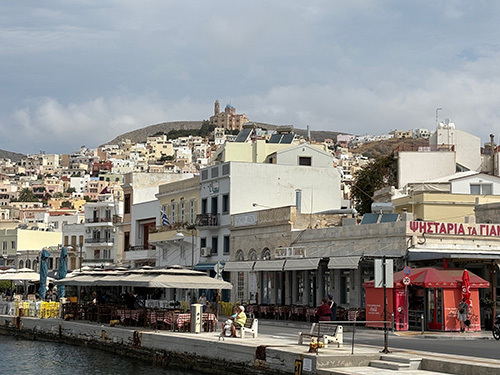 Port of Ermoupolis
Port of ErmoupolisWe traveled by ferry, the same strategy we’d used for island-hopping back in 1990. Fortunately, there are plenty of ferry companies in Greece that run much more smooth and comfortable transportation than in the past. I remember from the late time I visited in 1990. Huge ferries like those run by the efficient Seajets company can take 2100 passengers and hold up to 600 cars. Rides can be as short as half an hour or as long as twelve hours, with plenty of stops at islands large and small. Ferries have seating similar to a plane’s economy, business and first-class sections, albeit far more relaxing and uncrowded. Restrooms, bathrooms, and coffee and snack bars abound—and it’s easy to change your seat, as long as you are in the correct cabin.
The ride from Crete to Syros was about six hours, so we went with a “platinum” seating category. You check your luggage in an area on the entry deck, where cars park around the sides. I felt a little nervous to leave our two suitcases in the luggage rack for Syros, but I was relieved to see most of the passengers and luggage was clustered in the area bound for Santorini (of course). This made the accidental removal of our suitcases seem less likely.
Upstairs, we relaxed with coffee in our comfortable window seats with extendable footrests. We heard lots of American English around us all the way to Santorini. It was just two hours from Crete to Santorini, and at that destination, two-thirds of the cabin disembarked. Within ten minutes, another great throng filled in the seats, most heading for Piraeus, the port near Athens.
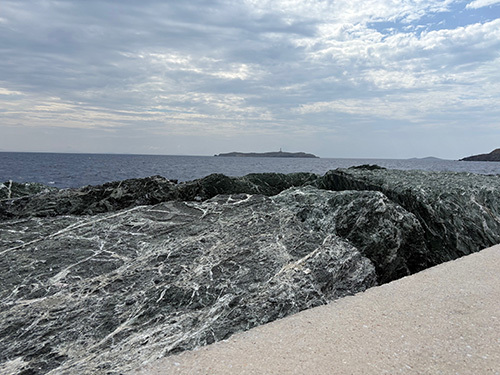 Port of Ermoupolis
Port of ErmoupolisThe word Cyclades is an Anglicized reworking of the Greek word Kyklades referring to the circular position of this island group in the South Agean Sea. 32 out of the Kyklades’ 220 islands are inhabited—and some of the uninhabited ones have great historical and spiritual significance and have legal protection against visitation. Syros is the largest island in the Cyclades, with a population just over 21,000, and is known as the island that stays open year-round. Syros is still a place where people work in the shipyards or farming and making cheeses, honey and also having art and craft galleries and shops. But primarily, Syros has the long-lived prestige of being the legislative center of the Kyklades, ensuring a constant stream of Greek citizens with legal business. There is a neoclassical urbanity to most buildings in Ermoupolis that gives this island a more international feeling than other Greek islands I’ve had the pleasure of visiting.
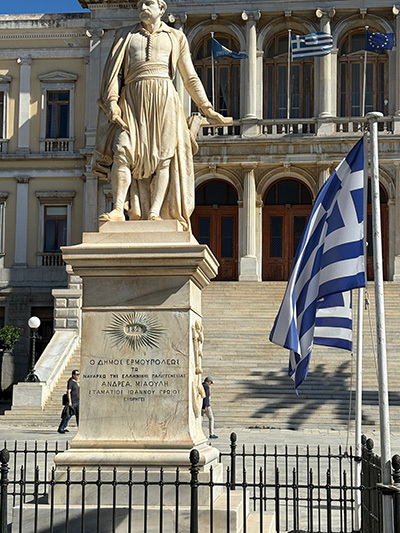 Town Hall of Ermoupolis
Town Hall of Ermoupolis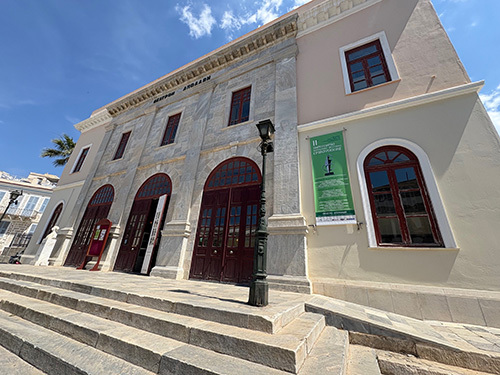 Apollon Theater
Apollon Theater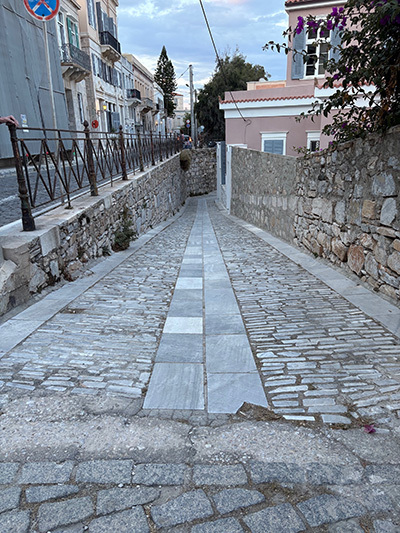 Entrance to Historical Museum of Hermoupolis
Entrance to Historical Museum of HermoupolisArchaeological evidence of human habitation on the island goes back to 3000 B.C. Through the turbulence of the Crusades and beyond, different countries claimed Syros as theirs, but this island did not suffer as much as some other places. Syros had the unique situation of being a place with both Catholicism and Greek Orthodox churches, making it a refuge for some during political upheaveals. This legacy of immigration and self-sufficiency, plus an excellent location close to Asia Minor, made Syros a center for shipbuilding and textile production in the 19th century. It became the second richest location in Greece (after Athens) during this era, and is still known as the capitol of the Cyclades islands. With prosperity, the arts thrived—and at one point there were five opera houses on the island. Its predominantly neoclassical architecture is different from the boxy, small white houses throughout most Kyklades islands. Life goes on year-round for local people, and there’s now a significant cohort of artists, designers and digital nomads living on the island.
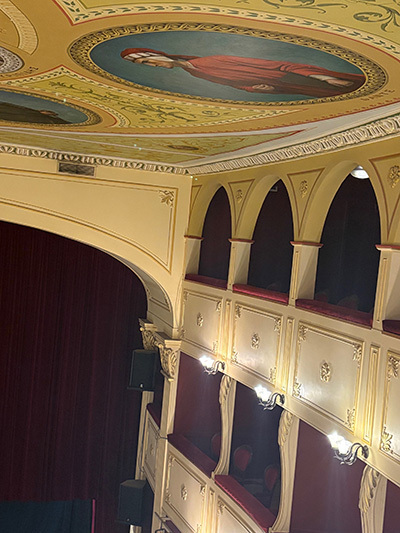 Restored interior Apollon Theater
Restored interior Apollon TheaterI was impressed by the old-fashioned look of the curving harbor when the ferry pulled in. Only about twenty people got off. A waiting taxi carried us on a brief uphill climb to our lodgings, Hotel Aristide, a renovated Venetian palazzo owned by the writer Oana Aristide, her sister and mother. The design and comfort was exquisite and it’s been recognized as a Michelin-starred hotel. There are quite a few hotels in historic mansions scattered through Ermoupolis.
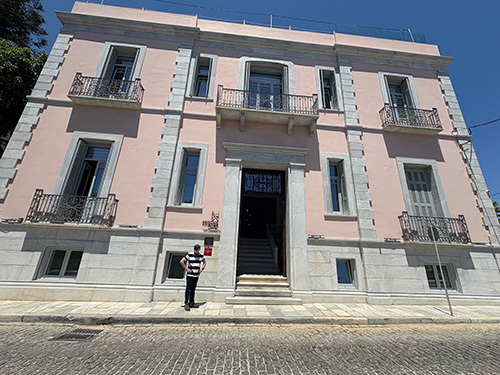 Hotel Aristide
Hotel Aristide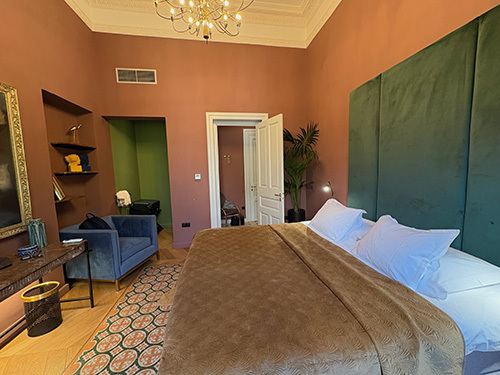 Kirki Suite bedroom
Kirki Suite bedroom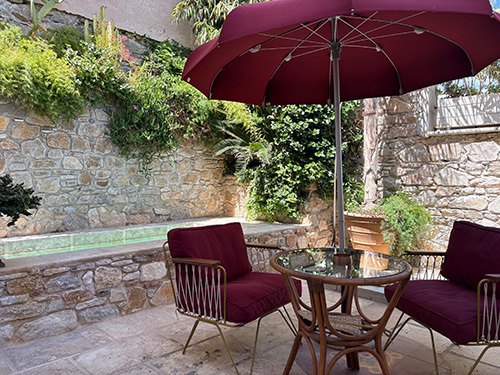 The Kirki Suite had a terrace and plunge pool
The Kirki Suite had a terrace and plunge poolHow incredible it seemed that all the streets were paved in marble—soft hues of cream, gray and pink that were accented in the colors of the stucco houses.
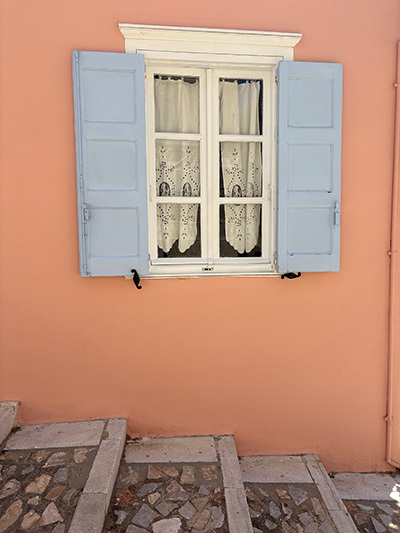
Later I was to learn marble is an intrinsic part of Syros’s geology. Huge marble boulders made up the seawall near the port, and all other areas of Ermoupolis were cobbled in marble—the more industrial neighborhoods had tumbled marble, rather than the polished tiles of the Vaporia district.
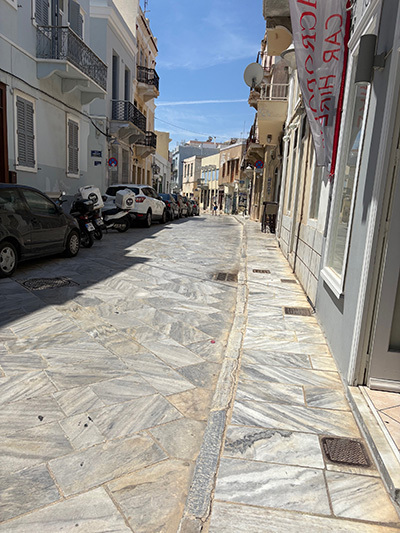
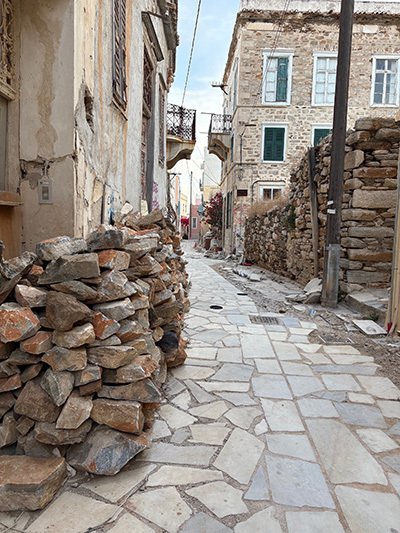
Flights of outdoor marble steps led upward from many streets on the island and opened into charming lanes, with houses set on either side. Not only did we see many small historic houses occupied by local families, there were also plenty of abandoned dwellings awaiting renovation. Historic preservation guidelines in Ermoupolis are strict, and while this ensures the area looks uniformly like itself, progress can be slow. Probably if I had stayed a few days longer in Ermoupolis, I would have been swept up in real estate fever myself.
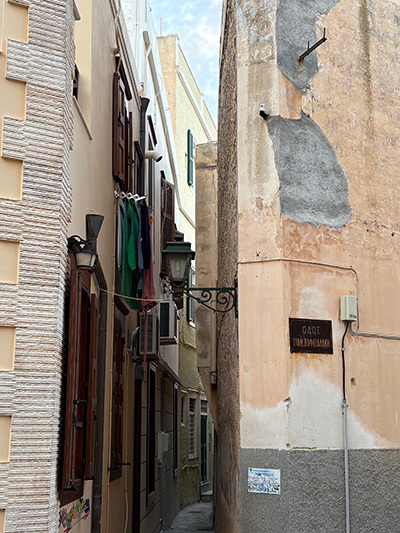
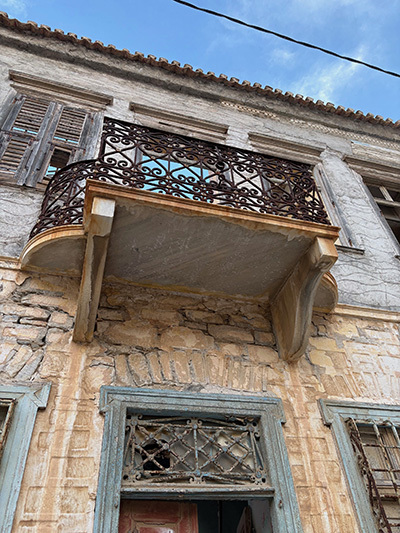
The neighborhoods were drop-dead beautiful—and the bonus was that the townspeople were friendly and there was an existing infrastructure of lovely restaurants and shops. Fabulous public buildings like the neoclassical Apollon Theater, modeled on La Scala, still hold regular performances, and we heard about a rock concert with international artists taking place just after we would head out.
A small number of artists have camped out for good on a special part of the island, the historically Catholic village of Ano Syros. This is a white-washed paradise full of narrow exterior staircases that can only be traversed on foot.
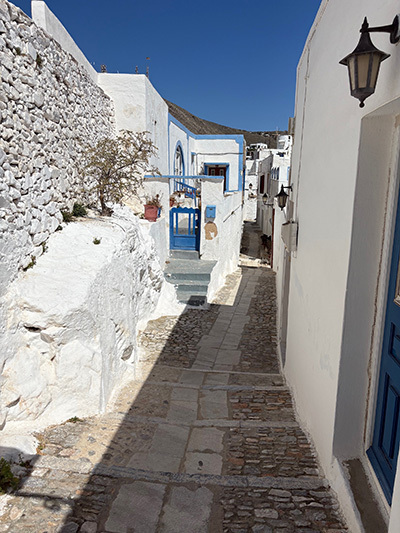 Ano Syros Lane and Agio Giorgios Cathedral, below
Ano Syros Lane and Agio Giorgios Cathedral, below
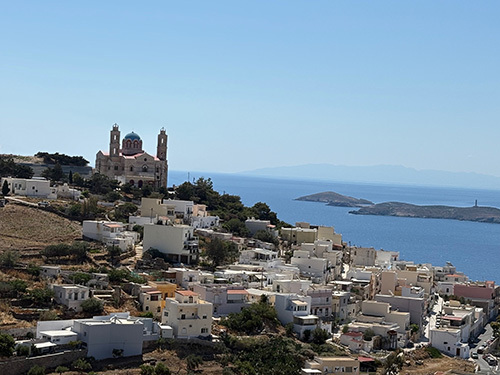
Tony and I had planned to walk from Vaporia to Ano Syros using Apple Maps. After experiencing just a few uphill staircases, though, my right knee protested. So, we went down the stairs to the town square and got a cab ride. The driver stopped at the edge of the village and urged us onward. We followed to the village’s famous Catholic church, Agio Giorgios. This was first built in 1200 and was rebuilt several times, including after a 1617 destruction by Ottoman invaders. Now it is known as the cathedral for the Roman Catholic Archdiocese of Syros and Milos.
The highly decorated sanctuary hadn’t changed since the 1830s and provided a deep, contemplative space from its spot at the top of the island. We stayed there for a while, imagining worshippers of the past—and all the steps they would have taken, several times a week, for their spiritual wellbeing. Syros is a windy island, which would certainly add to the challenge, especially during winter.
After a refreshing lemonade in a small café, we skipped down a few hundred steps and then took a straight path back to Ermoupolis. We ran right into a small archaeological museum and stepped through the door and saw treasures that had been unearthed in the 19th century and originally sent on to a museum Athens. All these were returned to the island, due to the islanders’ strong feelings, and this museum that they built to prove they could respectfully share the island’s history with visitors.
Only a few museums exist on the island, and they all run on odd hours, a few days a week—at least in the shoulder season. And the delight was we didn’t share space with many other people, any time we were in such a venue. We noticed tourists tended mostly to be Greek and over thirty. Where were the partying kids so common elsewhere in Greece?
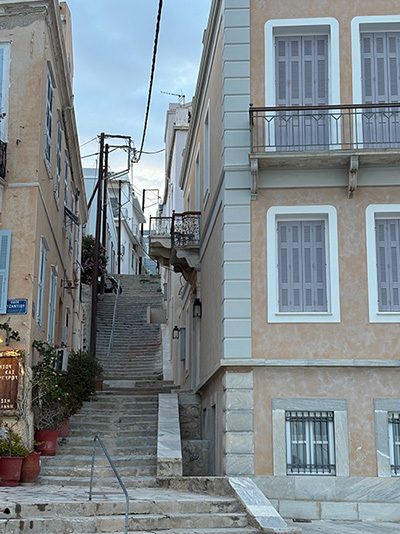
A university lies somewhere on the 32-square-mile island, but I didn’t see it, nor any beach resorts. The truth was, we stayed close to Ermoupolis because we didn’t want to rent a car again. The stress of navigating very narrow, busy streets in Crete had worn us out. Ermoupolis is very walkable, so we took taxis three times on the island. We were surprised that the drivers wouldn’t take tips, and the fares they asked us for were quite low: ranging from 5 to 10 euros. This built a feeling of gratitude and trust.
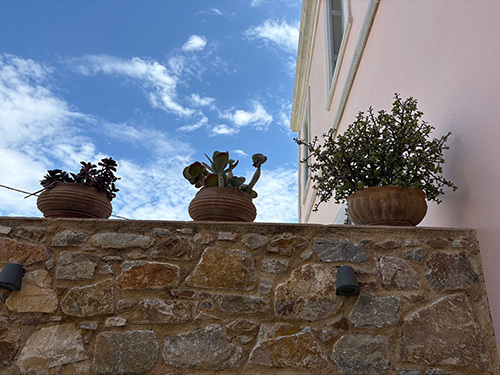
Although English is less widely spoken on Syros than Crete or nearby Mykonos, a small but significant contingent of foreigners live year-round on Syros. These are digital nomad families who rent apartments and send their children to a flexible “worldschool” and daycare set up by Boundless Life, a company that has a few sites in other European countries. It’s an interesting strategy that schedules families to arrive together at a certain time, live in furnished apartments, share co-working space and develop friendships. A French musician who moonlighted as restaurant manager at the Aristide, and who’s lived on the island more than twelve years, thinks the digital nomad program has been a plus. Alex pointed out the program rents properties from local landlords during the cold season and families buy what they need from local merchants and restaurants and shops. Most significantly, there is now an English medium school with an international baccalaureate to the island—building opportunities for cultural and linguistic connection.
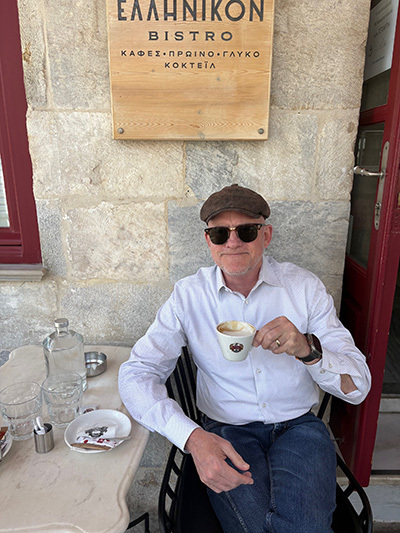 Tony was looking more Greek every day
Tony was looking more Greek every dayThe negative impact of tourism, especially crowding of public areas and conversion of local housing to Airbnbs, has been a source of anger in Portugal and Spain. It seems to be less virulent in Greece. Could this be because Greece’s visitors are spread out over so many islands? Granted, there are islands with tourist overload—see Part 3, yet to come in this trilogy of blog posts!
I was happy to investigate many small mom-and-pop restaurants serving mostly Greek and Italian food, as well as local fish, octopus and squid. Syros has a delightful market area selling local cheeses, honey, meats, fruit and freshly caught fish. In the heart of it is a casual restaurant called Street Food where I had an outstanding, simple meal of spinach rice, and chickpeas braised in tomato.
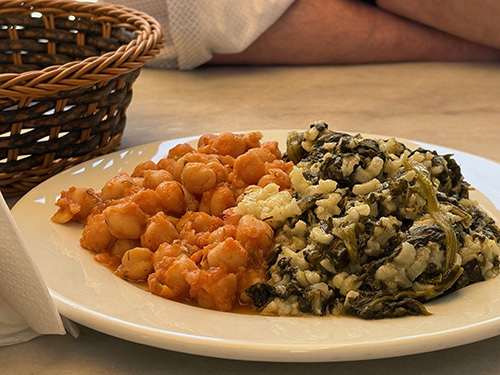
And what great cappucino can be ordered at the dozens and dozens of coffee shops! Many cafes could be found near the port, in the shopping district, and around the lovely town square. One of Greece’s most famous ice cream shops, Django, has its original location in the market area of Syros. It was here that I ordered a cup of sorbet, a half portion of pistachio and vanilla sorbet each. I wouldn’t have thought of mixing my order, but the young man behind the encounter insisted that it was the only correct combination. I liked the strength of his opinion—and the sorbet tasted like full-fat gelato!
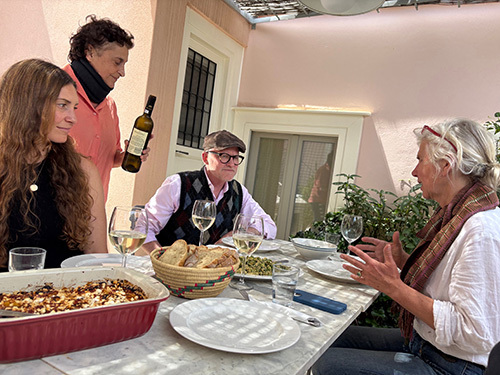
Our appetite was strong on Syros, and the most delicious and enjoyable meal we had was a lunch cooked in a cooking class in one of the glorious old Vaporia mansions. Here we met Eliza, a Greek lady from the mainland, retired from being a translator, who fell in love with an islander and the island herself. Eliza and her husband Kostas renovated Villa Maria, a late 19th century Venetian-style palazzo on a narrow lane that serves as both an inn and a cooking school. During Eliza’s Saturday class, we met four other Americans and a German.
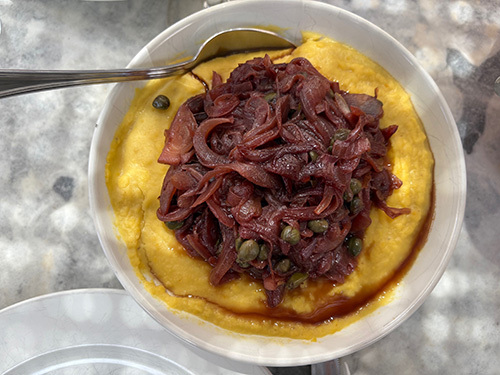 Fava married with capers and red onions
Fava married with capers and red onions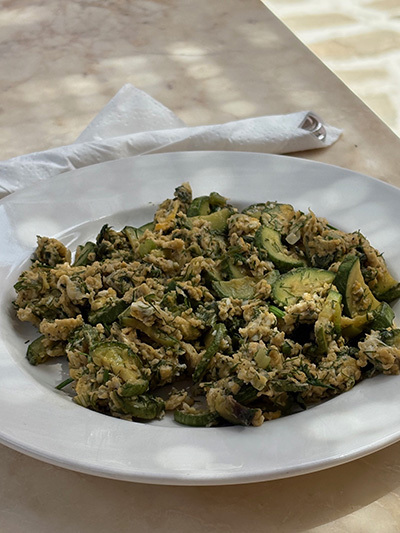 Tirititim: a Syros specialty with zucchini and egg
Tirititim: a Syros specialty with zucchini and eggSome of my favorites out of the seven dishes we cooked were fava, yellow split peas with caramelized red onions and capers; a delectable baked dish of eggplant and potatoes and tomatoes that was not moussaka; vine leaves baked with a tangy solid yogurt filling; and a dessert pie of baked milk and semolina. The simplicity of Greek ingredients makes the vegetables stand out and the food taste heavenly. Eliza kindly emailed her precious regional recipes to all of us, and I approximated the fava just a few days ago.
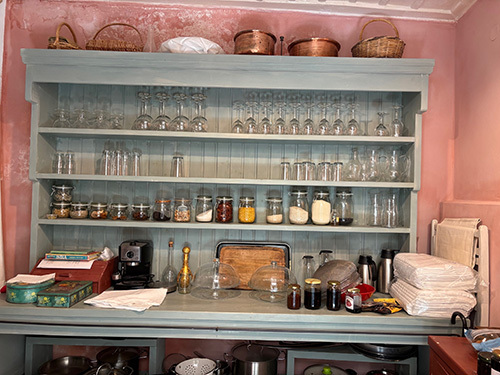 Eliza’s traditional kitchen
Eliza’s traditional kitchenIt’s hard to put into words why Syros put such a spell on me. Perhaps it was the mix of sophisticated and simpler but charming houses set against the coastline, or maybe it was the lowkey friendliness and honesty of the locals. Syros is kind to tourists: and because it doesn’t depend on them for life, that makes a significant difference.
After five pleasant days, I sailed away thinking: I might like to break my explore, explore, explore pattern when it comes to Greece, because I’d love to imagine Syros could be my own homecoming isle.
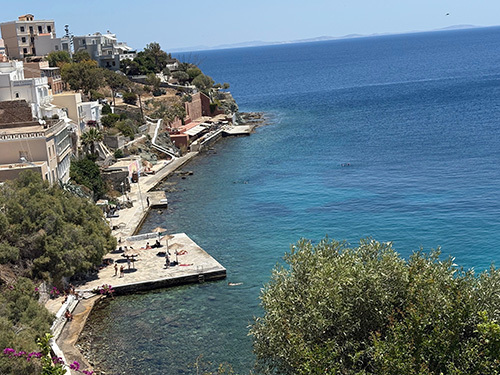
The post Sweet as Syros appeared first on Sujata Massey.
June 5, 2025
A Greek Odyssey, in Three Servings
This post originally appeared on Murder Is Everywhere.
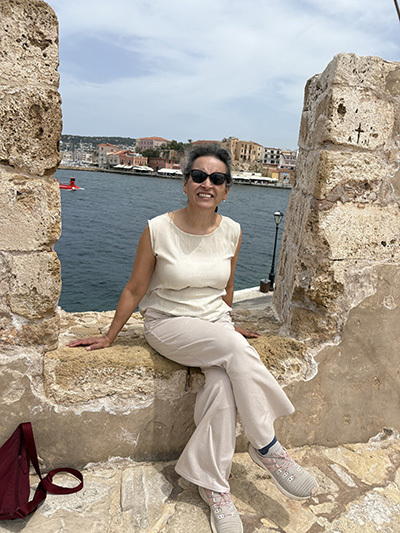
Our trip to Greece was impulsive.
Let’s go! I said to Tony, my husband and frequent travel mate. Let’s go to the islands again.
I’d made the same suggestion 35 years ago. We were former college classmates whose deep friendship was becoming a fledgling romance. A two-week trip was a celebration of Tony’s medical school graduation—and also a special time for our budding romance.
I researched the islands that were supposed to be high in beauty and lower on tourist kitsch. I bought reasonable tickets from a travel agent. Tony applied for his first passport and gamely agreed to the islands I’d selected: Sifnos, Naxos and Santorini.
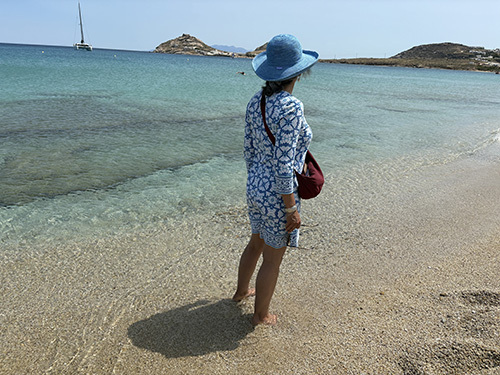
Greece in the spring of 1990 had just a sprinkling of European tourists, excepting, of course, Santorini. Overall, in the three places, we recall the kindness of the people, the grandeur of the mountains and azure sea, the crispness of the salads and the sweetness of the honey.
What nobody could have expected were the inevitable travel hiccups. Episodes like getting off a ferry to wait on the dark, early hours on Sifnos beach; arriving in our swimsuits at water too cool to swim in; Tony’s ankle sprain on the erratic staircases of Naxos, and my full-throttle sickness traveling on a hydrofoil. Tony was the one who held the bag. And the genius of these troubles were how they proved we could work together even through embarrassment and pain. The relationship was sailing ahead! A year later, we married.
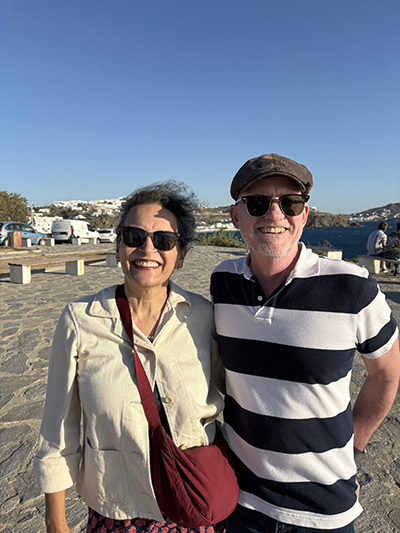
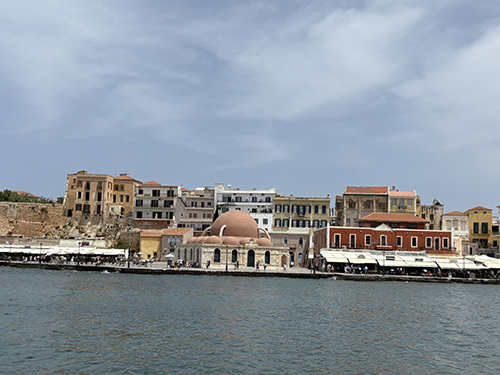 Old Venetian Port, Chania
Old Venetian Port, Chania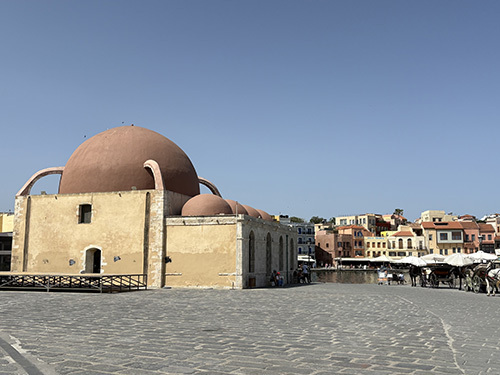 Kucuk Hasan Pasha Mosque
Kucuk Hasan Pasha MosqueThis year, as news about the difficulties of airport exit and entry spread, I felt urgently that I still wanted to travel—to be free in the world. Having already been in India, I felt the European Union countries calling. And I remembered the birthplace of my lasting love: the Greek islands.
Once again, I was the primary trip planner, and with over 240 inhabited Greek islands, there was a lot left to see. I landed on Crete, Greece’s largest island, with many places to go and a distinctive cuisine; Syros, the longtime legislative capital of the Cyclades, a marvel of marble sidewalks and grand Venetian style houses; and Mykonos, an international party hub truly chose only because it’s a seasonal home of my dear friends Jeff and Barbara Siger.
Even though we are older and wiser, we still had a big travel snafu. Hiccup One was arriving in the charming and small Chania, Crete airport on a British Airways flight that hadn’t loaded our luggage at Heathrow. We were in Chania two-and-a-half days without suitcases .
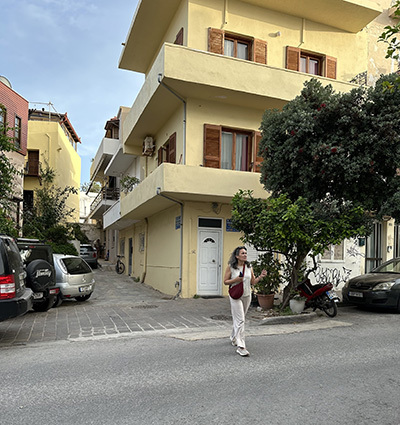 My plane outfit carried me for days
My plane outfit carried me for daysOur historic Airbnb, Casa Regina Luxury House, was in a tiny lane and wasn’t an easy delivery address, so it was only thanks to our kind landlady calling the airport that our clothes were ultimately delivered. In the meantime, we washed our travel clothing, and I bought a linen dress at a shop in Chania’s Oldtown to feel more culturally appropriate for visiting monasteries. The two monasteries we visited, Moni Ayia Triadha near Chania, and Moni Arkadhi near Rethymno, were remote, uncrowded sanctuaries.
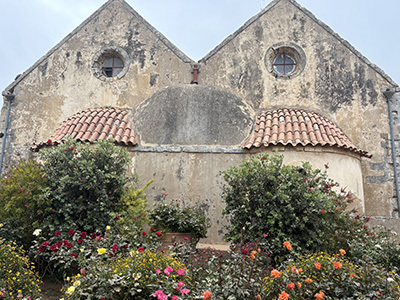 Ayia Triadha’s lovely gardens
Ayia Triadha’s lovely gardens
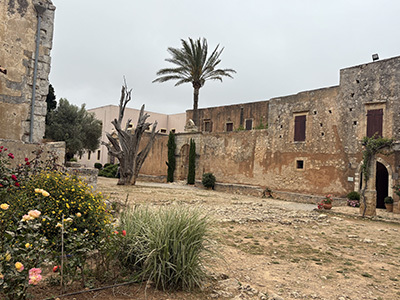
Ayia Triadha is still inhabited and has lovely gardens and produces its own olive oil and wines. Arkhadi dating to around 1100 AD is preserved clearly as a museum. The monastery was famous in the 17th and 18th centuries for exquisite goldwork embroidery and manuscript copying. It is best known as a holocaust setting in 1866, when 966 Cretan Christians came to stay with the monks to themselves during the period of Ottoman Turkish reign. A fierce battle attack from soldiers led not only to deaths by gunfire, but also of self-immolation in the compound’s powder keg. The treasures and tragedy are both brought forward in the tranquil location.
We rented a small car—and driving to this monastery, and then bringing the car through a medieval town to park, was very hard. I’d label driving Hiccup Number Two, and Tony was gracious enough to handle all of it!
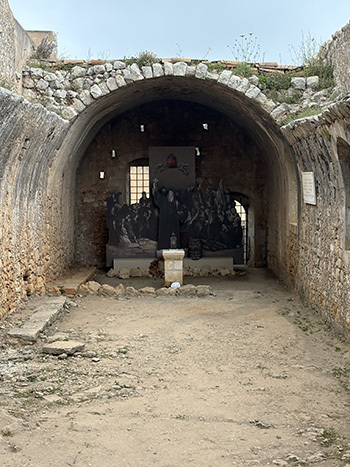 Scenes from Akhadi
Scenes from Akhadi
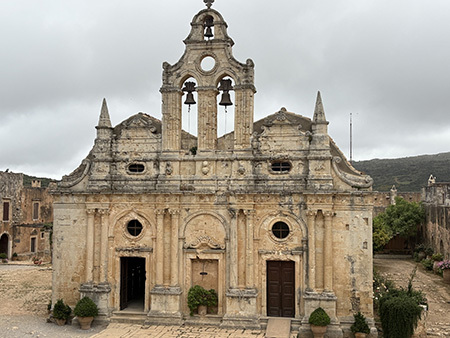
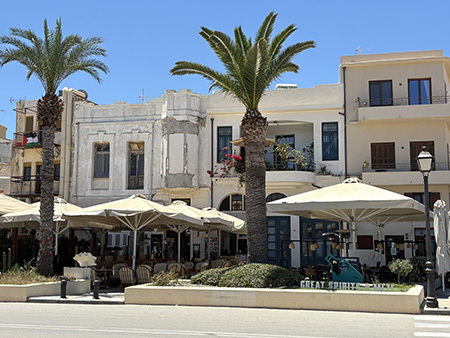
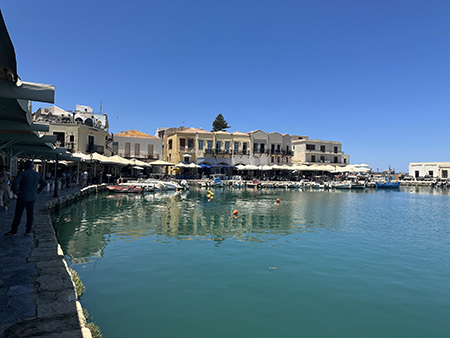 Rethymno port
Rethymno portNext stop: another of Crete’s medieval Venetian-Ottan towns, Rethymno.
Rethymno was slightly less crowded with tourists than Chania. It has a similar Oldtown to Chania marked by winding lanes and picturesque narrow houses. Here, many local people lived in these homes, and while tourism employs some citizens, the majority are involved in other work. We noticed a strong emphasis on restaurants serving locally sourced food and “Creative Cretan Cuisine.” A very good omen!
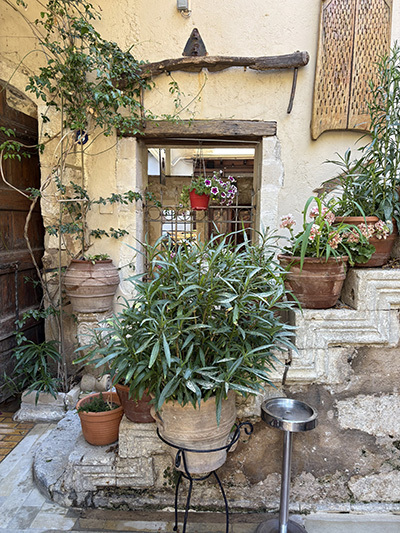

We hit gold with our small hotel, Avli, located on a tiny lane in an 18th century palazzo with a courtyard garden restaurant. Our small boutique hotel was quiet at night and gave us the pleasure of feeling like we were in a neighborhood with people of all ages, going about with their everyday lives.
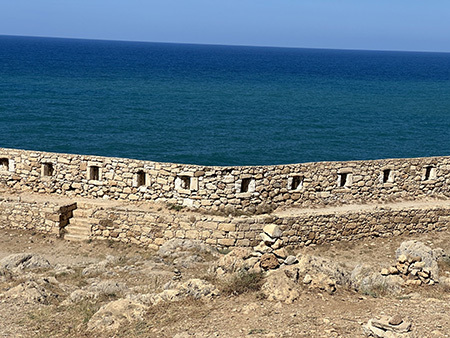 A fortification at Forteza
A fortification at FortezaThe big historic site in Rethymno is a Venetian-built fort known as the Forteza. Its walls were too low to serve as much of a stronghold against the Egyptian pirates and later-arriving Turks. Chiefly, Forteza was a location for Venetian administrators to live and work, while native Cretans preferred to build houses lower down in the city. We were impressed by the finely woven textiles, basketwork, ceramics and wood and stonework at the Historical and Folklore Museum in Oldtown.
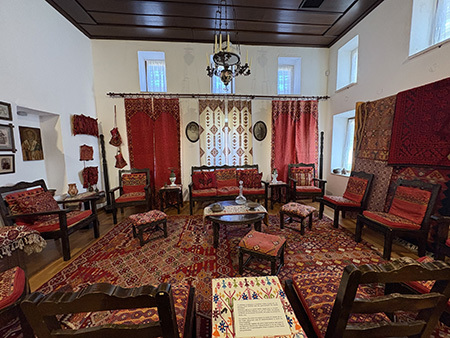
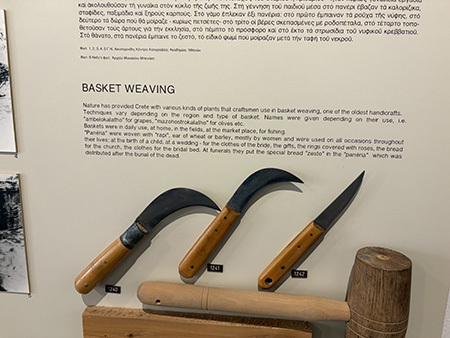
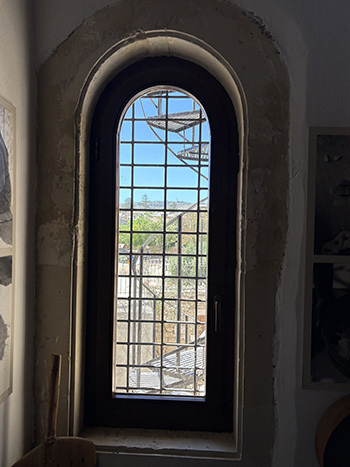 Rethymno Historical Folklore Museum
Rethymno Historical Folklore MuseumThis small and special museum was created by local family donations, just like a wonderful small museum we found in a historic house in Gavalochori, a village in the Apokouronas area near Chania.
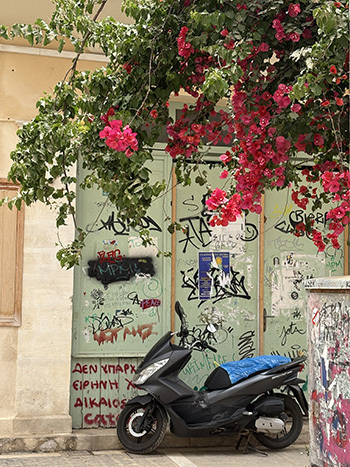
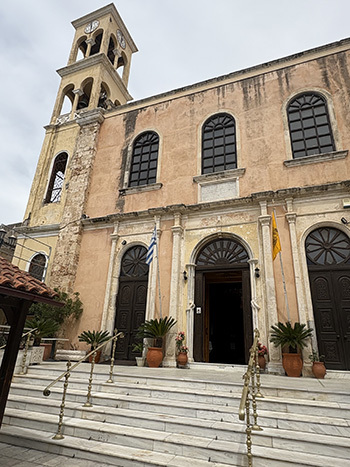
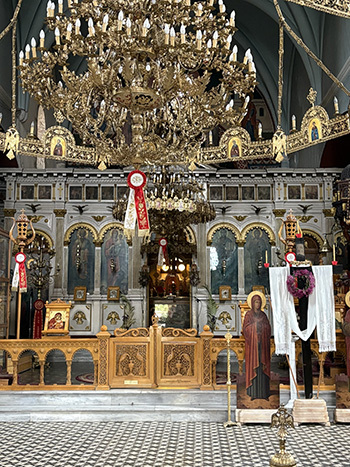 Ayios Nikolaos Greek Orthodox Church
Ayios Nikolaos Greek Orthodox ChurchDuring our time in Crete, I pondered over something with Tony. I know that I especially enjoy places that are beautiful and retain history. I love planning for these places and will read about them ahead of time. I know just a few words of the Greek language, which makes me dependent on local people speaking a bit of my language when I get there. I hope to visit “friendly” places, with locals not being angry about the disruption of foreigners. Such a welcome is the essence of being a tourist. Yet at the same time, I carry a secret wish not to want to see that many other outsiders around us in the streets. And what an impossibility it is to hold both things—but it did happen in some places on this trip.
We had a strong feeling of gratitude to the land and people of Crete when we boarded a Seajets Ferry early on a Wednesday morning, heading for Island Number Two: Syros.
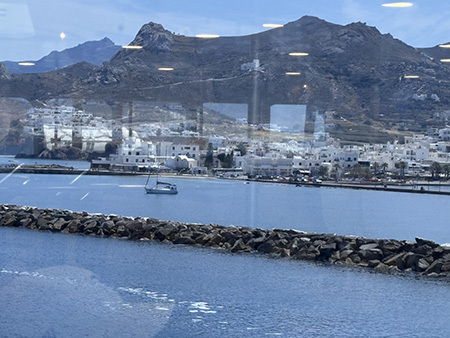
The post A Greek Odyssey, in Three Servings appeared first on Sujata Massey.
May 7, 2025
An Interview with the Museum Detective, Maha Khan Phillips
This post originally appeared on Murder Is Everywhere.
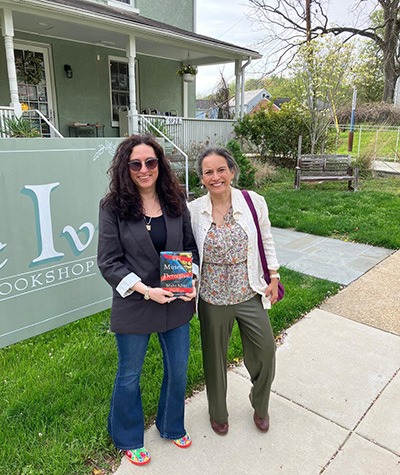 Maha and Sujata (Jumana Dalal)
Maha and Sujata (Jumana Dalal)Maha Khan Phillips is a seasoned journalist and novelist based in London. She’s just been published for the first time in the US with her remarkable mystery novel, The Museum Detective. This is a suspenseful story set in Karachi, Pakistan, where Maha was raised, and features a young woman archaeologist, a mysterious female mummy, and a city gone wild with suspense over the find. Karachi comes to pulsating life in this book, which presents a nuanced picture of how women are soldiering forward in the professions and in their own hopes and dreams for good lives. The book’s subplot is an incredible story about a missing teenager, and the power of individual courage, and compassionate friends. Maha answered my questions about her book in front of a rapt audience at The Ivy Bookshop in Baltimore a few weeks ago. Here is how our conversation continued!
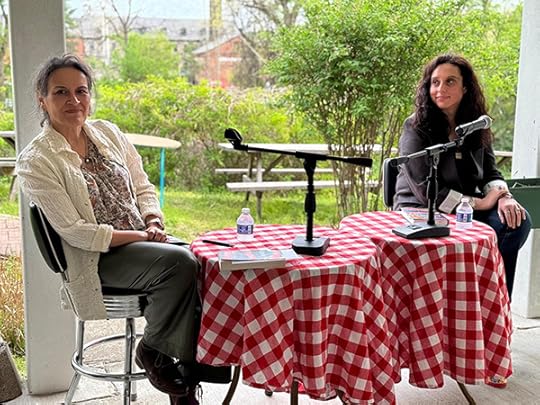 Onstage at Ivy Bookshop in Baltimore (Jumana Dalal)
Onstage at Ivy Bookshop in Baltimore (Jumana Dalal)
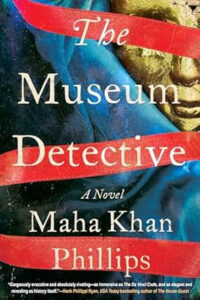
When did your interest in archaeology begin—was it with the news story about the mysterious mummy found in Pakistan, or much earlier?
Oh it was much earlier. I can actually pinpoint it exactly to the 5th grade, when we went on a school field trip to the ancient Indus Valley Civilisation site of Mohenjodaro, dating back to approximately 2500BC. I remember the journey to the site vividly – we flew from Karachi in a tiny plane and landed at an airport built especially for the site. We spent the entire day roaming around and exploring. I stood inside the Great Bath, which was probably used for ritualistic bathing, and I closed my eyes and thought of people swimming there thousands of years before. You are not allowed to step in it anymore but back then, it was magical. I often wonder why I didn’t consider archaeology as a career but it took me years to realise how deeply I loved immersing myself in the ancient world. Today I am an enthusiastic amateur who has been lucky enough to visit some really fascinating places.
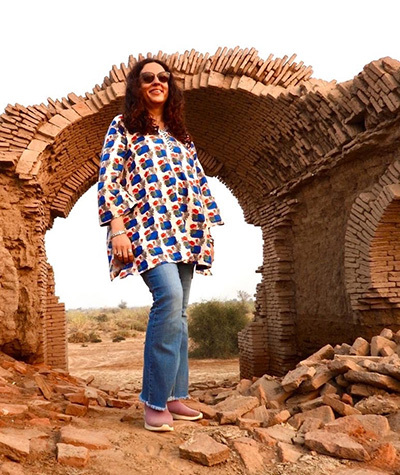 Maha on-site (Adnan Noon)
Maha on-site (Adnan Noon)Where else in the world, besides Egypt, are mummies found?
All over the world, though notably, the Indian sub-continent is one of the few regions where mummies don’t generally tend to exist. As far as I’m aware the Chinchorro mummies of Chile are the oldest known deliberately mummified bodies. Their process involved peeling the skin off a body like a sock, treating the bones, and then reconstructing it with clay, ash and sticks. The skin would then be reattached and painted. Gruesome, but fascinating! In Japan, certain Buddhist monks actually self-mummified through extreme fasting and meditation. The Guanche people of the Canary Islands buried their mummies sitting upright under the ground or in caves. There are mummies in China, in Europe, Siberia, and various parts of Africa.
What is the most interesting mummy fact you found out while researching this novel?
The Victorian obsession with mummies was absolutely bonkers. Despite their horror of cannibalism they were busy grinding up mummy bones into all kinds of potions and lotions and tinctures. From the Middle Ages to the 19th century a substance called ‘mumia’ – derived from mummified bodies – was used across Europe for its healing properties. One detail that really stuck with me was that since the time of the pre-Raphaelites, mummies were used for making pigments. The paint colour ‘mummy brown’ was really popular, particularly during the Victorian era, and it was made from the bones and juices of Egyptian mummies. Amazingly enough it was available for purchase until 1964, when the last manufacturer, C Robertson and Co, announced that it could no longer offer it because it had run out of the body parts.
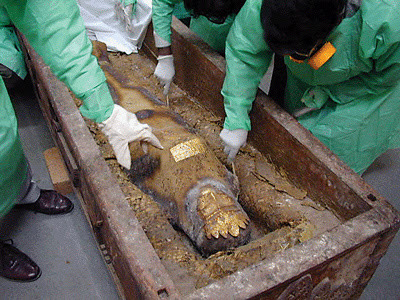 The Persian Mummy (science.org)
The Persian Mummy (science.org)There’s a true story that inspired The Museum Detective. Can you tell us about it?
In the year 2000 police in Karachi arrested two men attempting to sell a mummified body that they claimed was an ancient Persian princess named Rhodugune, a daughter of King Xerxes, one of Persia’s greatest rulers. They wanted $11 million for her. Police confiscated the body, and it eventually made its way to the National Museum of Karachi. Its discovery caused a sensation. If genuine, it would have re-written history, and the mummy would have been priceless.
A geopolitical tug of war began as a result. Iran demanded her repatriation, and even the Taliban tried to claim that the body was stolen from their land. The international archaeological community got involved as well.
And then Dr Asma Ibrahim, a Karachi-based archaeologist and museologist, proved that the mummy was a fake. She could also have been a murder victim, as evidenced by her broken neck and the blunt force trauma to her body. Once the mummy was exposed as a forgery, global interest vanished. The woman’s body was stripped of its value, and she was eventually buried in an unmarked grave with the help of Asma and the Edhi Foundation. To me that was the most haunting part of the story, how her worth eroded when her body could no longer be commodified. She became yet another unknown victim.
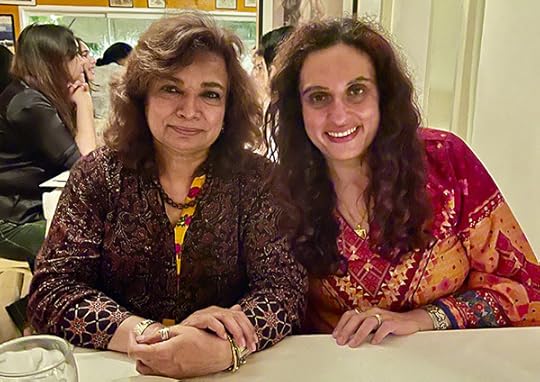 Asma Ibrahim and Maha (MKP)
Asma Ibrahim and Maha (MKP)Who is your heroine, Gul Delani?
I loved writing the character of Dr Gul Delani. She’s 36, whip smart and unafraid to speak her mind. She is a museum curator in Karachi with multiple university degrees from around the world, and a background in Egyptology, though she knows many different ancient languages. She has returned to Pakistan for personal reasons and she doesn’t suffer fools gladly – she’s got very little time for showboating or museum politics in particular. Gul is intellectually curious and she believes in justice. She also carries the emotional weight of her niece’s disappearance three years earlier, a mystery that haunts her. Gul is more or less estranged from her family, having rejected the life they expected her to lead. Instead she surrounds herself with a quirky, deeply loyal group of chosen family who support her emotionally and help with her investigative pursuits.
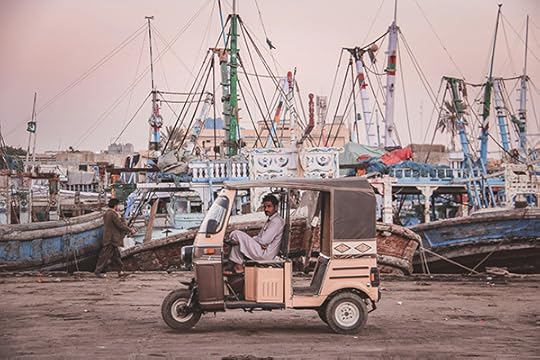 fishing boats in Karachi (Kashif Afridi on Unsplash)
fishing boats in Karachi (Kashif Afridi on Unsplash)You show us life inside a conservative Islamic nation that shows its citizens enjoying trendy styles, modern music and ostentatious wealth. Is this typical of Karachi? How is Karachi different from Islamabad and Lahore?
Karachi is incredibly complex. It is a sprawling, diverse port city and economic hub with over 20 million people from all walks of life. In the case of The Museum Detective, many of the characters from Gul’s family are from a wealthy elite – modern, flashy and global in outlook. But Karachi also has a rising middle class that engages with both Eastern and Western cultures and values, and communities that are deeply conservative and even extremist. It is a city of contradictions. I haven’t lived in Lahore or Islamabad but from the few times I’ve visited Islamabad, it’s always felt more orderly and bureaucratic – and, personally, a little boring in comparison! Lahore is much more of a cultural heartland and glorious to visit but less of a melting pot. In Gul’s case, her found family – especially her Goan Christian secretary Mrs Fernandes – reflect Karachi’s multi-culturalism.
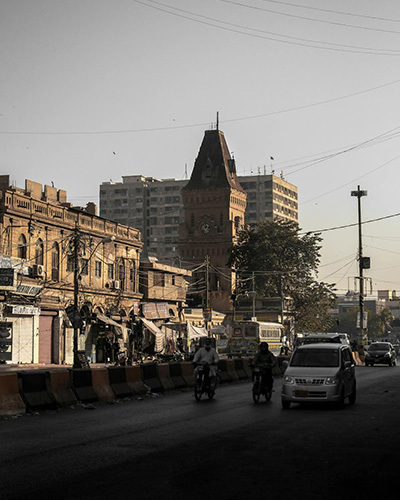 Empress Market (Naweeb Khan on Pexels)
Empress Market (Naweeb Khan on Pexels)You name a fundamentalist political party and have its followers threatening action against the heroine, Gul. How do you keep yourself safe when traveling and doing research?
Well, it’s one of those situations where you’re perfectly safe most of the time, but it can never hurt to be careful. There are some things I just wouldn’t do on my own, for example I would never visit some areas that are quite remote in Balochistan or in the interior of Sindh without a convoy of other people, even though that’s where some of the most fascinating archaeological sites are. But I’ve travelled with friends and with family, with and without security, and honestly, I’ve found the bureaucracy to be more frustrating than any actual danger.
There’s a point in the book where scholars of different nations all try to claim a right to the mummy. Is this something that typically happens when there’s an archaeological finding in Asia?
I think it happens any place where there is a cultural, ethnic or historical overlap, or colonial history or looting of stolen heritage. I live in London now, for example, and I often visit The British Museum and stare at the Parthenon Marbles, wondering how their continued possession by the UK can still be justified. In terms of the Indian sub-continent, I think what’s happened to the narrative around the Indus Valley Civilisation is really interesting – who gets to claim ownership of history. There are modern political narratives in both India and Pakistan that try to take a shared multi-ethnic, multi-regional civilisation and fold it into the idea of a single nation state. Clearly, that’s not reality.
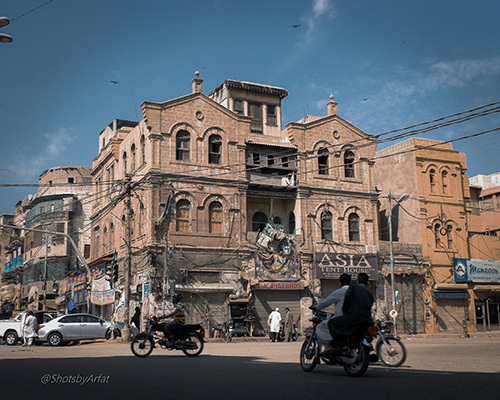 Saddar Karachi (Arfat Jabbar on Unsplash)
Saddar Karachi (Arfat Jabbar on Unsplash)Which countries are publishing this book?
To date it’s been published by Soho Crime in the US and is being published this summer by Westland in India and Liberty Books in Pakistan. It will also be published by Shueisha in Japan.
What’s your next book project?
Gul is back! She’s investigating another murder, one that is tied to mythologies around reincarnation, which I’m really excited about. I’m also exploring some elements of faith and superstition, as well as feudalism in Pakistan, and trying to spend some time portraying the younger, edgier side of Karachi as well. I’m not sure how it’s all going to shake out yet but I’m eager to find out!
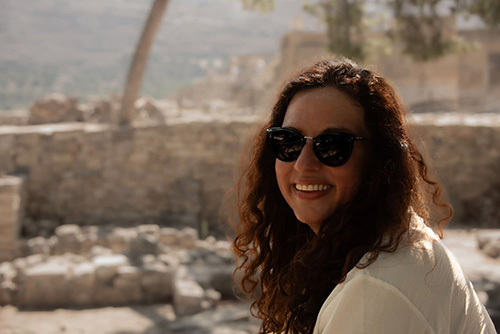
The post An Interview with the Museum Detective, Maha Khan Phillips appeared first on Sujata Massey.
March 26, 2025
A Twisting Trail to Kodagu, aka Coorg
This post originally appeared on Murder Is Everywhere.

Has a place name caught your ear and not let it go? I have always felt that way about the region in Karnataka called Coorg. The name of the hill station is so unusual. It’s mysterious, while still being easy to remember.

This past January, I finally reached Coorg and learned that the name has roots in colonialism alone. In the 1830s, when the British deposed the local Raja, they swiftly annexed the land and renamed the place called Kodagu, which has civilization dating back to India’s Sangam period, 300 BCE. The land known as Coorg was incorporated into the new state of Karnataka in 1956. Today, Kodagu is the district’s official name, but Coorg is what lots of people still say and write. The area is known for deep green mountains, coffee plantations, and people who are incredibly warm—and physically strong. The regional identity is defined by its minority indigenous community called the Kodava, people who may have originally come as Kurdish exiles from Iraq or with the military forces of Alexander the Great. To this day, the Kodavas are admired for their skills in hunting and military service.
We came from Mysore by car for a two-day visit. The first driving hour was easy on smooth roads. The last two hours were a stomach-testing, bumpy and twisty journey into the beautiful green hills.
When we got out of the car at the Coorg Wilderness Resort, I realized we had entered the coldest place I’d ever experienced in India, with temperatures in the fifties and sixties daytime. I wrapped up in my cashmere shawl and kept it on for the rest of the stay.
Monkeys were everywhere! The clever girl photographed below became our frenemy. She waited near the suite till we were gone and then jumped down from the roof to our balcony and turned the handle of the closed door to go inside. Indoors, she located a closed can of almonds with a picture of the nuts on the can. She skillfully ripped off the metal lid, devoured the almonds and scampered through the suite, enjoying herself, until she was shooed out by the arriving cleaner. Even after the crime, she lingered near our door, giving cool stares that reminded Tony and me that she had rights to the place.
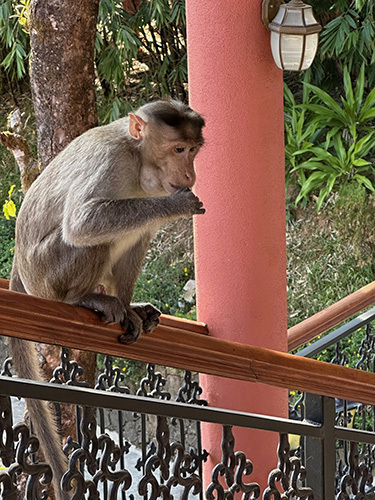
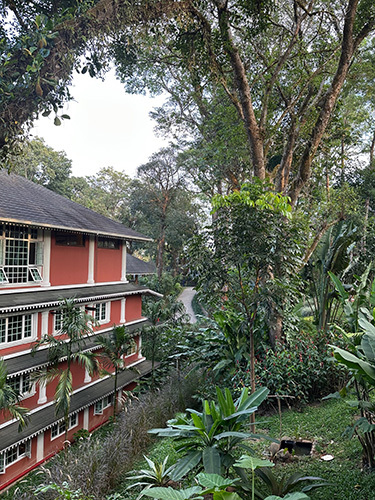
I’d seen the resort in brochures and online photographs and thought from its appearance that it was a renovated coffee plantation. My eyes had fooled me. The property was just a few years old but built in a convincingly traditional style and furnished with neo-Victorian furniture and textiles. Most rooms were a steep hill walk down from the reception building and hotels, but little electric carts whizzed about by young local drivers took care of any exhausting climbs, especially at night. The hotel buildings were painted cheerful red. Guest suites were almost all located up flights of stairs and had private balconies and terraces overlooking the rolling hills. At least part of my guess was correct: the vast lands included a small coffee plantation with beans being grown, roasted and shared with other properties in their group, the Paul John Hotels.
The food was extremely tasty, with most of the fare South Indian. Large buffet meals were included in most people’s room packages, but we found the hotel’s small restaurant that specialized in Kodava dishes, very enjoyable, both for the food and the company of local people. Local mushrooms, greens, and bamboo shoots were combined in curries that made an intriguing meal that seemed to taste of the mountains.
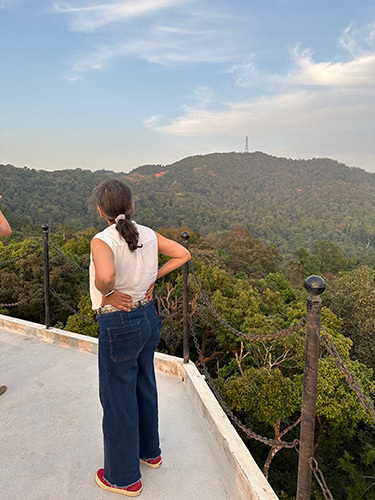
Hiking, swimming in a pool, visiting the hotel’s farm and learning about coffee production were all offered as activities. Most of the resorts’ clients were multigenerational Indian families. While climbing uphill on a hike to the lookout point shown above, I fell sharply and was worried my throbbing quadricep would prevent me from walking back downhill. One of the tourist families had chartered an all-terrain vehicle going along the same rough path and gave me a seat, for which I was extremely grateful. For the next eight days traveling in India, my bruised thigh slowly healed.
Fortunately, I was still mobile enough to walk short distances. In nearby Madikeri, Tony and I visited a fort dating from the early 1600s that, during British occupation of the early 1800s through 1947, was used for administration, as well as a small Anglican church. Strolling through this church, we studied a plaque engraved with names of British parishioners who’d left the paradise of Coorg to fight and ie in the World Wars. No longer used for services, the small Gothic building had become a museum of Indian history, with cases filled with local archaeological finds, many of them stone tablets and statues of Hindu and local deities.
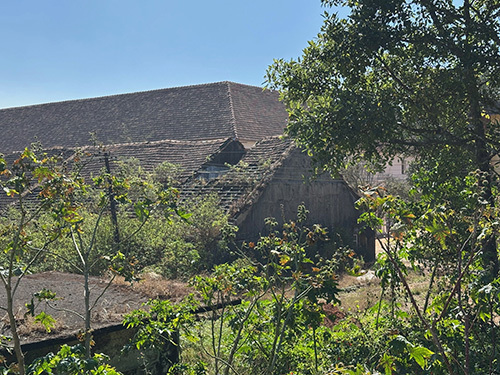
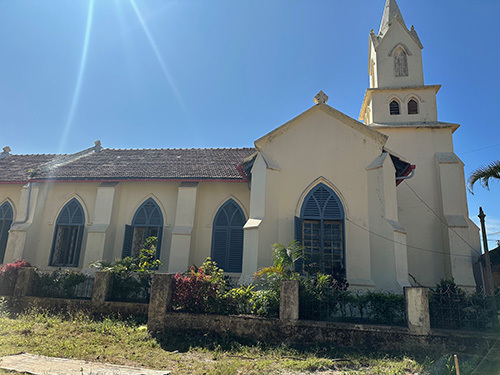
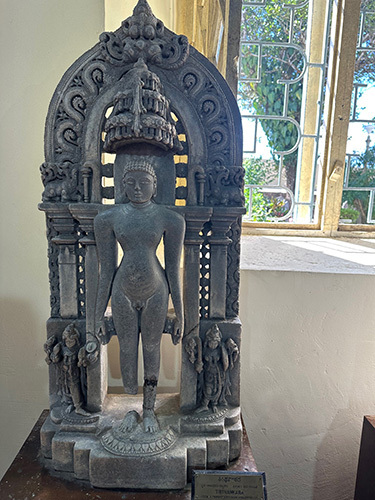
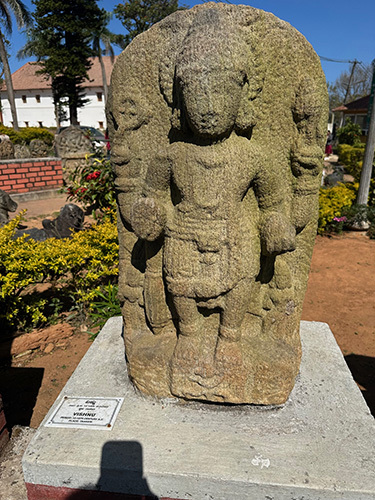
One of India’s most distinguished military combat officers, General Kodendera Subayya Thimayya, came from a Kodava coffee plantation-owning family. The general, who was known in his youth as Dubbu to his family, became “Timmy” to the British and the outside world. Gen. Thimayya studied at the Bishop Cotton boarding school in Bangalore, the Prince of Wales Royal Indian Military College, and finally at the Royal Military College in Sandhurst, where he was one of only six Indian cadets. During World War II, Timmy was the only Indian who commanded an Infantry brigade; after the British left, he rose in the Indian Army, becoming the 3rd Chief of the Army Staff of the Indian Army from 1957 to 1961. He retired and then served as Commander of the United Nations Peace Keeping Force in Cyprus, where he died of heart attack while on active duty at the age of 59.
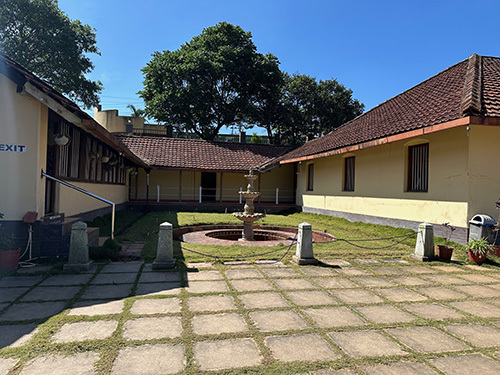
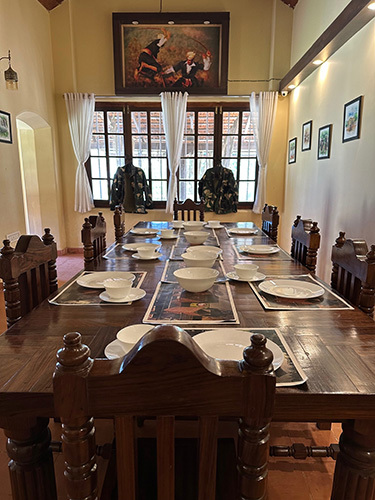
It was delightful to talk with a retired soldier manning the visitor desk at Gen. Thimayya’s childhood home in Madikeri, which is now a museum. I enjoyed walking through and getting the sense of what a wealthy planter’s home was like. I was pleased to see a room devoted to information about the general’s wife, Nina, who was an accomplished dancer and had lived in France before their marriage, and other rooms had displays that told stories about his siblings and his children. The Thimayya house was one of the best sightseeing opportunities in Kodagu, which really doesn’t have the multiple temples, museums and shops in most Indian tourist destinations. Truly, the place is about being away from the world and in nature’s embrace.
In the center of Madikeri town, we sampled delicious cappuccino from local beans and deliberated over the varieties of coffee we would buy and share with friends as we traveled on in India.
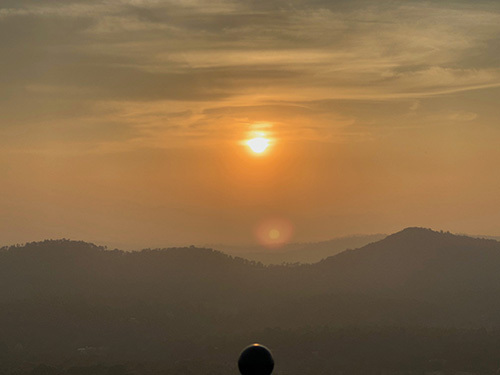
It was sad to watch our last sunset from the balcony at the Wilderness Resort. But the long ride down from the mountains had another excitement in store: the Namdroling Monastery, a Tibetan Buddhist refuge and learning center. The monastery was built in 1963 when the Tibetans were welcomed to India after Chinese persecution.
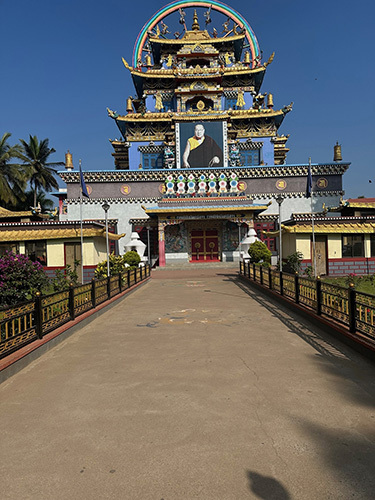
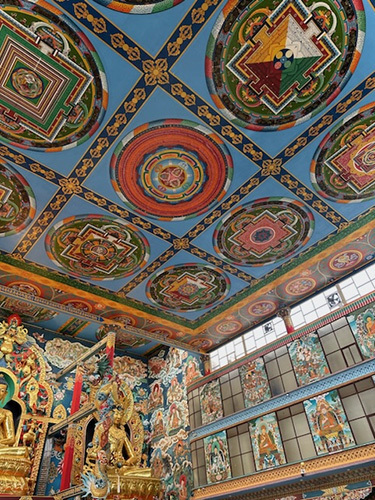
The initial structure for the monastery was just bamboo, and the early monks had to fend of wild animals as they built in the jungle. The community raised money and have built the monastery into a gilded, impressive complex for monks and their families. The day we visited, many monks seemed to be hastening away down the road from the monastery. When we came upon police cars closing off the exit, we learned that the Dalai Lama was visiting for a few days, and the monks were going to meet him. No such chance for us; but we considered it a brush with greatness and another example of how Kodagu might appear like a sleepy mountain hideaway, yet have a powerful impact in the larger world.
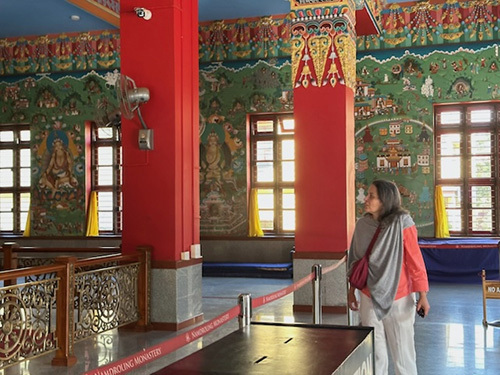
The post A Twisting Trail to Kodagu, aka Coorg appeared first on Sujata Massey.



